- All Product Reviews
- (Open Giveaways) US&CAN
- (Open Giveaways) Canada Only
- (Open Giveaways) USA Only
- Past Winners
- Family Travel
- Parenting & Tips
- Crafts & DIYs
- Financial Tips
- Health Tips
- Cleaning & Kitchen Tips
- General Tips
- Online Sites to Visit
- Our 2023 Holiday Gift Guide
- Our 2022 Holiday Gift Guide
- Our 2021 Holiday Gift Guide
- Our 2020 Holiday Gift Guide
- Our 2019 Holiday Gift Guide
- Our 2018 Holiday Gift Guide
- Our 2017 Holiday Gift Guide
- Our 2016 Holiday Gift Guide
- Our 2015 Holiday Gift Guide
- Our 2014 Holiday Gift Guide!
- Our 2013 Holiday Gift Guide!
- Our 2012 Holiday Gift Guide!
- CANADA LINKS


Getting the Most out of Fire Station Visits
I have a toddler that is obsessed with all things firefighting. She has been for over a year now. It’s serious. She has made her own fire extinguisher out of craft supplies, she watches combat competition videos on Youtube, she points out every hydrant, standpipe, valve, alarm, sign and fire truck that crosses her path. She maps out evacuation plans in every building we enter. And most importantly, we visit fire stations to talk to firefighters. Often.
Whether you call them fire stations, houses or halls (we call them stations where I come from), these buildings are EVERYWHERE. There are likely several in your community, and at least one within walking distance of your home. If you have a “Jr. Firefighter” like I do, a visit to your local fire station is inevitable. Go prepared.
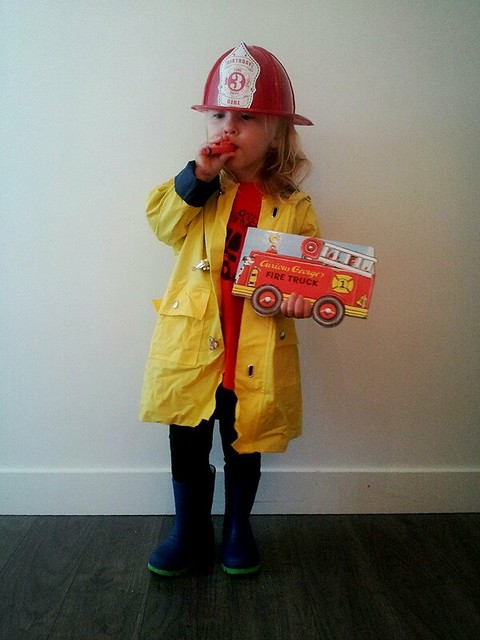
Since we’ve now visited several dozen fire stations in multiple cities across North America, I’ve created a list of tips for parents and kids to get the most out of a visit to a fire station, whether it’s your first or twenty first visit.
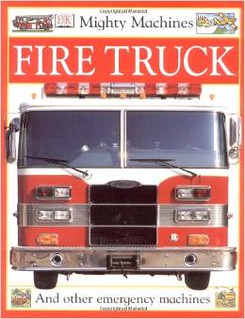
BEFORE YOU GO:
Read books on firefighting to familiarize yourself with the vocabulary of firefighters. Knowing terms like what a fog nozzle and telescoping ladder are make it easier to point out items you see around the station and ask questions about them. We like the DK Books in the non-fiction area of the library like “ Mighty Machines Fire Truck ” and “ A Day in the Life of a Firefighter .”
Make a thank you card for the firefighters. Going under the pretense of thanking the firefighters for their service to your community gives the trip more purpose and teaches your child about the value of civil service.
While fire stations are open 24/7 (for obvious reasons), they generally prefer hosting little visitors during daylight hours. Call ahead to the station you wish to visit to get a feel for when they would prefer you stop by.

THE DAY YOU GO:
Warn your child that if the firefighters get a call before you arrive or while you are there, they will have to leave the station and not be available to visit with you. Be flexible to visit later if you see there are no trucks in the bay.
Wear your favorite firefighting gear. My daughter has several fire truck shirts, a chief hat and various costume pieces she wears when she visits fire stations.
Plan to spend no more than 15 minutes in the station on any one visit. It’s a place of business, so they must stick to a schedule.
Prepare a list of 3 or 4 questions for YOUR CHILD to ask the firefighters so he/she can learn something new on each visit. Your child can also bring one of the library books to look at with the firefighters and ask any questions you have about what you see or read in the book. By having your child communicate directly with the firefighters builds public speaking confidence and a positive relationship with civil servants. My daughter has talked to dozens of firefighters and they have ALWAYS been incredibly awesome with her. The usually squat down to look at her in the eyes and she has gotten very comfortable talking with and learning from them.
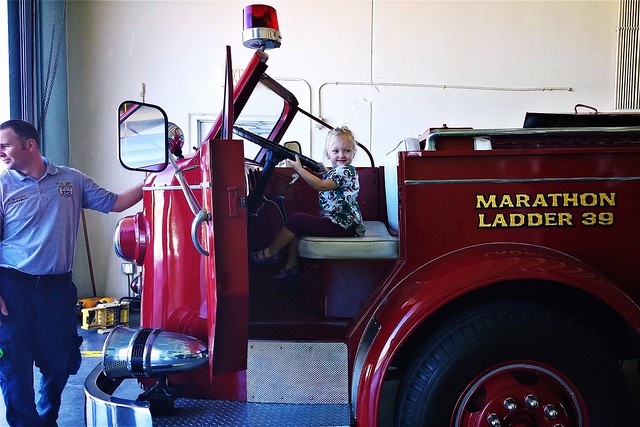
QUESTIONS TO ASK AT YOUR LOCAL FIRE STATION:
- I live at XXX address. How long does it take for you to get to my house in the event of an emergency? (They usually have a map on the wall and can point at your house and the station and talk about the route they would take.)
- If I get hurt at home and need to call 9-1-1, should I specifically ask for fire response? (In some areas, the responders are equally trained and one has a faster response time than the other, so it’s important to request the faster service if seconds count in your emergency.)
- Does this station have an ambulance?
- If I got hurt and you needed to take me to a hospital in the ambulance, which hospital would you take me to?
- May I see the inside of the ambulance so I know what to expect if I ever have to ride in it?
- If you live in a high rise, you can ask if their truck ladders can reach your floor of the building. If they can’t, you can talk about the best evacuation plans based on the age of your building (different building codes determine where the safest places in the building are. Newer buildings have specially designed stairwells that keep fire out.)
- If you visit frequently, you can learn the names of the crew members (see my Final Tip below on how to address firefighters by name) so you can have more social follow-up conversations like learning where they went to fire school, what they do for exercise during off hours, etc.
- Where do you train? Is there public viewing of the training sessions? (some stations have public viewing of hose and ladder practice, but it’s likely on the outskirts of town where there is more space to make a mess.)
- What are your most common calls – fires, injuries, people getting stuck, etc?
- What are ways I can stay safe so I don’t need to call 9-1-1?
- If I DO need to call 9-1-1, what information should I have memorized (address, last name, etc.)
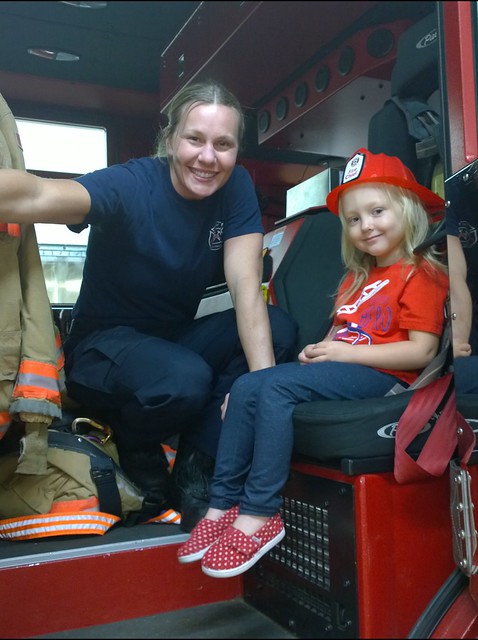
QUESTIONS TO ASK AT NEW FIRE STATIONS:
- May we have a tour of your station? (Some walk you through the kitchen and sleeping quarters, some have museum memorabilia in the lobby, most just show off the trucks and common areas but we’ve found that each station tour is different and unique.)
- May we see the inside of one of your trucks? (Most will let your child sit in the truck, some will turn on the sirens – either way, be prepared to take pictures)
- Do any female firefighters work at this station? (It’s good for kids, both girl and boy, to meet females who have worked hard to break into the male-dominated profession.)
- Does your fire station have a pole? (Ask gently if someone will demonstrate, but be prepared for a “no” since some find it annoying to use the pole).
- How old is this fire station? Do you have old pictures of the building? (Some have pics of when the trucks were pulled by horses which is cool).
- Any interesting facts about this particular fire station or crew?
- Do you have a fire dog/boat/helicopter at this station?
- What is the newest or coolest piece of equipment you have in this station?
- Do you give hose demonstrations? (Some firefighters will spray a hose at the truck or let your little one hold the hose… it depends on the location of the station and what the water restrictions are in your area.)
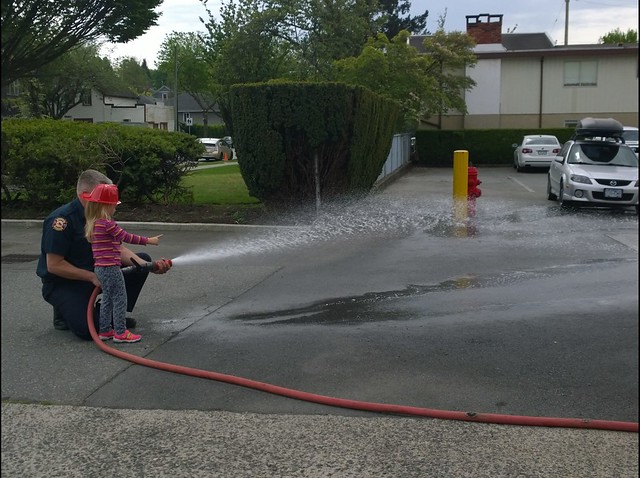
Ask if this fire station has any special events coming up. (Some host dinners or open houses for the public.)
Ask if there is anything you can do or bring on future visit to help them? (Some may appreciate snacks, etc.)
Courteously ask if they have any stickers. (Most stations offer stickers, temporary tattoos or hats to little visitors. At one station, my daughter got a cool t-shirt. Say lots of pleases and thank yous.)
As you leave the station, while everything is still fresh on the brain, talk to your child about things they saw that were new or interesting to direct future learning. For instance, at one station, my daughter was allowed to hold a fire hose and spray the parking lot. Afterwards, she wanted to learn more about the specific nozzle she operated so we went home and looked at Youtube videos demonstrating the nozzle and we even found one video of the factory MAKING the nozzle.
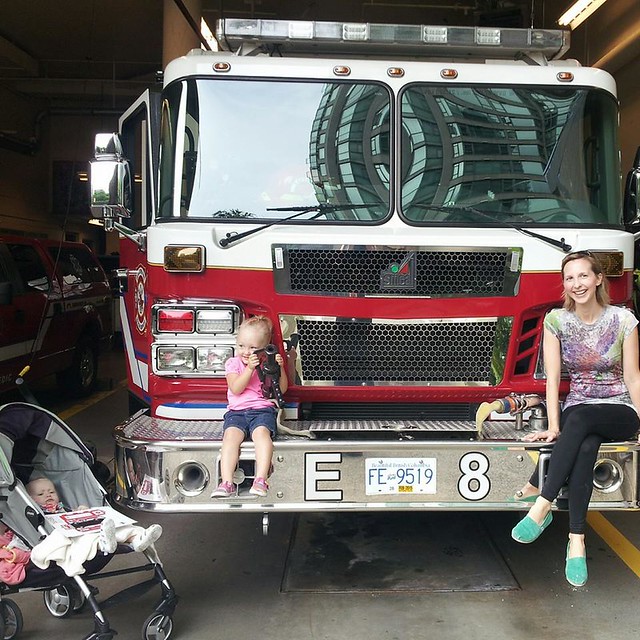
Respect that the fire station is a place of business and that while they welcome little visitors, they really can only take about 10 minutes to host you. If the bell rings and they have to take an emergency call, you must get out of the way immediately and let them take off on in the truck. The excitement of the call is usually enough to distract little ones from the fact that the tour got aborted, but mitigate melt-downs by explaining ahead of time that emergency calls take top priority.
Don’t harass your local station. If it were up to my toddler, we’d visit our neighborhood station (only a few blocks from our home) daily. We limit in-person visits to once every two weeks, and just wave at the station as we walk past in between visits. If any of the firefighters are out in the driveway as we walk past, we stop for a quick hello, but not for a full visit inside.
If your child wants to learn the names of the local firefighters, be sure to ask how they wish to be addressed. Office titles are hard to achieve, so should be respected. Address a Lieutenant or Chief as such unless they say otherwise.
Remember that firefighters are there to help you, so if you have any questions or concerns about personal or property safety, ask! They have great information that will reduce your likelihood of actually having an emergency. The goal is to get the info during friendly visits so you don’t ever have to call them in a crisis.
About the Author Allison Baltzersen
Allison Baltzersen is a green mama, raising her two little girls to enjoy childhood, ask lots of questions, and be kind to the Earth.
posted in: Lifestyle , Parenting & Tips , Tips // 16 comments
Leave a Reply Cancel reply
Your email address will not be published. Required fields are marked *
Save my name, email, and website in this browser for the next time I comment.
This site uses Akismet to reduce spam. Learn how your comment data is processed .
16 Comments on “Getting the Most out of Fire Station Visits”
it sounds like your daughter is going to be a fire-fighter at the earliest possible opportunity. Thanks for a lovely post, I enjoyed reading this. 🙂
I love seeing/hearing about children with a deep desire for a profession. My grandson loves how things are made and will watch/read anything he can find..
Allison, You have a very intelligent and motivated little girl. If she does not choose firefighting for a career, she will most certainly be a conscientious worker in whatever field she chooses.
Thank you so much for the detailed questions and instructions you gave so that potential small visitors to firestations would be prepared for such visits.
Fire station visits are always a fun time, and a great learning experience!
OMGosh, this is awesome! I love that you have a little girl who loves all things firefighting!!!! Love it… Thank you for this guide, its really thorough and comprehensive. Those are amazing pics… I have a great friend who worked really hard, as a woman, to qualify and become a firefighter; maybe someday I will see your daughter do the same thing.
This morning there are some folks from the local fire station bringing a truck to the school we attend for playgroup…..gonna be a great morning!
My boys had a school trip to the fire station and they just loved it!!! It was an excellent learning experience for them.
Great tips. I didn’t know fire stations were open to the public but have always known the firefighters to be extremely friendly and helpful during local event days.
What an awesome learning experience for the kids!!!!!
What a great adventure,my grandson would enjoy this
On the last week of preschool the kids got to visit the station and sit in the Firetruck,the kids were in awe
Fire station visits are always so much fun and the kids learn so much
I love to see children with an interest in a field
Girls can be anything they want
This was so cool! I’m going through the same thing with my daughter. & Have been for about a year. She is almost 3 so was thinking abt taking her down to the fire station! I appreciate this!
My girls loved it when we visited our local fire station a couple years ago.

Welcome to One Smiley Monkey
My name is Angela van Tijn, and I am the creator and writer behind One Smiley Monkey. I am passionate about writing, photography, hiking, travelling, exercising, and spending time outdoors with my family.
Get new posts in your inbox each week!
Recently….

Wholesome Shredded Apple Cake Recipe

Integrating Coding into Family Life: Fun and Educational Activities for Kids

Hop Into Easter Fun: Exciting Basket Gift Ideas for Kids! {Giveaway}

Different Maps Review: Beautiful Laser Cut Wooden Maps Art

New Easter Traditions: “Where’s Philbert?” Game and Purdys Chocolatier {Giveaway}

Unlocking the Power of Hydration: A Review of Vegamour’s New HYDR-8 Vegan Hair Products
Search the blog, latest on instagram.

- ^ Back to Top
- Work with Us
- Disclosure and Privacy Policy
©2024 OneSmileyMonkey.com. Design by Purr .

Visit the Fire Station!

We’ve visited the fire station a handful of times in the last few years. We most recently went for a scheduled tour with our church playgroup in July. There are lots of benefits to visiting the fire station, but the biggest (in my mind) was letting the children see a firefighter in his full gear (including the helmet and respirator).
I can imagine it being quite scary seeing a fireman in all his gear when there is actually a fire. Firefighters have said that some children have actually run away from them in an emergency situation because they were scared. Showing your child what a firefighter looks like fully dressed is a great way to prepare if a fire or emergency ever happens in your home!
Call your local fire station and see if you can schedule a tour. I’m sure they’ll happily oblige…especially if you bring them goodies!
Thanks to my friend Mercedes for this photo…I couldn’t find any of my pictures from our fire station tour!
Related Posts

Next week (October 9-15) is National Fire Prevention Week. We take fire pretty seriously in…

We can't learn about fire without learning about those who put them out...and their mode…

This alphabet craft was lots of fun to make and involved TONS of fine motor…
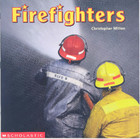
Here are some of our favorite books on fire and firefighters. Firefighters A to Z…

This post is sponsored by First Alert as part of the Mom It Forward Influencer…
Our church playgroup went to a nearby dairy farm today! We had so much fun!!!…
We visited a fire station on monday with my twin boys, they loved the trucks, but were freaked out about the coats and hats. I am glad we at least introduced them to the idea. They were given a bag of goodies, including a plastic firefighter hat, which they have warmed up to and insisted on wearing to the library today.
We arranged our visit because a fellow twin mom is a firefighter and she gave us the tour, but she said they give tours all the time, always free, for any size group. (ours was our family of 4, mom, dad, twin boys who will be two next month.) Totally worth calling to ask.
http://goteamwood.com/2011/10/10/fire-station-visit/
What a great idea! I never would have considered it. I can definitely understand why children might be frightened of firemen. I’ll have to look into doing this with my daughter!
You may have seen these “awards” floating around the blogging world, but I am officially giving it to you — The Versatile Blogger Award. :) http://inthesweetsunshine.com/2011/10/the-versatile-blogger-award/
Have a great day!
Leave a Reply Cancel reply
Your email address will not be published. Required fields are marked *
15 Fire Safety Tips for Kids (from a firefighter)
June 16, 2021
Josiah Raiford
Keeping your family safe during an emergency is a top priority from every parent, and the best way to keep your kids safe is to ensure they know what to do in case of an emergency. As a firefighter, I can tell you that kids love when we come visit and do school safety talks. So, why not reinforce that material at home too?
In this article, I’m going to give you some ideas for things you can do or teach your children about to help keep them safe.
Table of Contents
1. Take them to safety town
If you’ve never heard of a safety town , it may be the single greatest invention of public safety. It’s usually held at a local elementary school or junior high and run by firefighters from the community . Safety town teaches children the basics of fire safety, how to prevent fires and what to do in the event there is a fire.
Now, this doesn’t mean you stop your child’s safety education there, but it’s a good start if you child doesn’t know much about safety in the home.
Not all cities do it, but it’s certainly worth a call to your local fire department or city hall to see if they do it and how to register.
2. Teach them to stop, drop, roll
This is a must.
When people accidentally light themselves on fire the natural response is to panic and run. This is the worst thing you can do if your clothing is on fire . The reason is as you run it only fans the flames more and creates more fire.
The best thing you can do is stop what you’re doing, drop to the ground and roll back and forth to smother the flames.
Sounds easy, but when your adrenaline is pumping, you’re scared and you don’t know what to do it’s easy to revert to our natural response of running. It’s important your child knows that stop, drop and roll is the best way to keep themself safe.
3. Teach them about matches and lighters
This is another staple of fire safety education. Teaching your children that matches are dangerous and are to never be used unless in the supervision of an adult is imperative to their safety. It’s also important to mention that you should not be smoking in your home, but if you do and you use lighters frequently, make sure your kids know that lighters are just as dangerous as matches.
4. Have a plan in case of emergency
At every fire safety talk I have done I always tell the kids to make sure they make a plan with their family members of what to do in case of an emergency.
If you haven’t taken the time to make a plan, do it now. It’s simple and only takes a few minutes. Here’s a few things to keep in mind when making a fire safety plan.
- Where are the bedrooms, point of egress, and does each room have two ways out?
- Once everyone is out of the home, where will you meet up to get a headcount of everyone?
- Will one person be responsible for getting the pets?
- What will you do if one person is missing?
- Where will you go after the fire?
These are just a few tips to get the conversation started. Remember, this is important, and your safety and the safety of your loved ones may depend on it. Finally, once you’ve created the plan be sure to practice it at least once per year.
5. Teach them about smoke detectors
Smoke detectors have saved more lives than firefighters ever will. That said, make sure your child is familiar with the detectors and is involved with the maintenance (battery changes) of each detector in the home.
Have your children ever heard the smoke detector alarm ? If so, do they know what that means and what to do?
If not, now is the time to do a dry run and ensure they are familiar with the detectors, how they work and what to do if they hear one alarm.
No products found.
6. Check the windows – make sure they work
An important part of knowing two ways out is making sure that you can actually get out. It’s a sad reality that many people have passed away during a house fire because of a locked door or stuck window. Make sure your windows operate properly and a child would be able to open them.
Also, if you have some type of safety bars on the window, make sure there is a quick release and you’re able to release it in case of an emergency.
7. Mind your pots and pans
I think we’re all guilty of cooking something on the stove, getting distracted and wandering off not paying any attention to where the pot or pan handle is.
Make sure when you are cooking you rotate the pot or pan in a position where the handle does not stick out past the stove. It’s easy to overlook, but trust me, the consequences of a child accidentally pouring hot liquid on themselves are devastating!
Be sure to rotate your handles away from the edge of the stove.
8. Dial 911…with a cell phone
Now some children may still be too young, but if they’re old enough to understand how to use a phone teach them how to dial 911. It’s important to teach them not only how to dial 911, but what to do once they are connected.
>>>If you accidentally dial 911, check out our article here on what to do next.<<<
9. Teach you fire safety
Someone once told me that you haven’t really mastered something until you are able to teach someone else. In my experience, I have found this to be true.
That said, consider having your child give your family a class on fire safety. Start with the basics. Something like where in the house all the smoke detectors are, what the plan would be in case of a fire or why matches are dangerous.
This is an easy and fun way for your child to learn the importance of fire safety.
10. Memorize address and phone number
This is important, especially if they know how to call 911.
We would like to think that with todays technology 911 would be able to find us anywhere in the world at anytime, but unfortunately, that is far from the case. I can’t tell you how many times my crew has been dispatched to the wrong address or a completely different location from where the caller was located.
Because of this make sure your child has the address memorized and ensure they are able to recite it to a 911 dispatcher in case of an emergency.
11. Purchase a ladder if they’re second-floor bedroom
This ties in with the earlier tip of knowing two ways out. Being presented with the choice of being trapped by a fire or jumping from a second or third story window and getting hurt isn’t really a great option. The easy fix to this is to purchase an emergency ladder that can be quickly and easily deployed.
If you’re unfamiliar with these, here’s an example of what I’m talking about:
12. Visit the fire station
If you’re looking for an afternoon activity that your kids will love, consider taking them to the fire station for a tour. Parents and children come by our station all the time, and at this point, I’ve lost count of how many tours I have given.
In addition to being a fun activity, the fire department has a ton of fire safety information, toys and materials for your children. A station visit also familiarizes them with the fire department so that in the event something happens they aren’t scared to interact with the firefighters.
13. Get out, stay out – No exceptions
Once you’re out of the home do not go back in. This is more difficult than you would think as occasionally there may be other people or animals trapped in the home.
Make sure your children know that the only people who should enter a burning building are trained firefighters. We have special gear and equipment that allows us to be in environments that would otherwise severely injure a person.
14. Stay low for smoke
Contrary to popular belief, the leading cause of death from house fires is not burning. It’s from smoke inhalation. Smoke is made up of small particles , toxic gases and heat. Teach your children how to move through smoke (we do this at safety town and during school talks with the burn trailer). If there is a fire in your home it’s important for their health and safety that they know to stay low.
15. Careful of candles (consider alternatives)
This one goes hand in hand with the top about matches and lighters.
I get it, I love a good candle too, but if you have kids around please be careful with lit candles. It is too easy for a candle to get knocked over and start a fire. Make sure your child is aware of the danger that candles present and to never touch a lit candle.
Also, it may not hurt to consider using flameless candles until your children are old enough to understand the dangers of candles. Here’s an example of what I’m talking about:
Teaching your kids about fire safety doesn’t have to be boring. Take them to the fire station, look for a safety town near you and practice, practice, practice. It could make all the difference.

- Baby Sleep Workshop 💤
- Privacy Policy
- Search for...
How to Visit a Fire Station with Your Baby: Safe Havens & General Visits
- June 27, 2023
In a world where situations can sometimes be less than ideal, Safe Haven laws provide a secure and legal option for individuals unable to care for a newborn. This comprehensive guide aims to answer your most pressing questions about taking a baby to a fire station under the Safe Haven laws.
General Questions on Safe Haven Laws
What are safe haven laws.
Safe Haven laws, also known as Baby Moses laws, allow parents unable to care for their newborns to leave them at designated locations without fear of prosecution.
Safe Haven Law Age Limit
The age limit under Safe Haven laws varies by state but generally includes infants up to a few days or weeks old. Please refer to your local laws for specifics.
Safe Haven Fire Station: Can You Drop a Baby Off at a Fire Station?
Yes, in all states, fire stations are considered safe locations where babies can be left under the Safe Haven laws.
Safe Haven Baby Box: A Closer Look
What is a safe haven baby box.
Safe Haven Baby Boxes are secure, heated boxes where parents can place their newborns anonymously if they’re unable to care for them.
How Many Babies Have Been Left in Safe Haven Boxes?
The exact number varies each year and by location. For detailed statistics, it is best to contact a local Safe Haven representative or nonprofit organization.
What Happens After a Baby is Left at a Safe Haven?
What happens to safe haven infants.
Once a baby is left at a Safe Haven, they are provided with immediate medical care. If no parent comes forward, they are placed for adoption.
How Long Do You Have to Leave Your Baby at a Safe Haven?
There’s no mandated length of time, but once the baby is left and the parent leaves the premise, the Safe Haven procedure begins.
What is a Safe Surrender Baby?
A Safe Surrender Baby is an infant that has been legally and anonymously given up by their parent(s) under the Safe Haven laws.
About Parental Rights and Responsibilities
At what age can a mother leave her baby.
Under Safe Haven laws, a mother can leave her baby at a designated location within the legally specified age limit, generally a few days to a few weeks after birth.
Can I Leave My Baby at the Hospital If I Don’t Want It?
Yes, under Safe Haven laws, hospitals are designated safe locations. Be sure to confirm with your local laws.
Can I Keep a Baby I Found?
It’s essential to report any found babies to authorities immediately. Keeping a baby that’s not yours can have legal implications.
Planning a General Visit to the Fire Station with Your Baby
Aside from Safe Haven laws, taking your baby to a fire station can be an educational and exciting adventure. A visit to the fire station introduces your little one to the brave men and women who serve our communities, and also helps them become familiar with the sights and sounds of the firefighting world. Here’s how to plan a memorable trip:
Step 1: Schedule the Visit
Remember to contact the fire station ahead of time to ensure they can accommodate visitors. Firefighters have demanding and unpredictable schedules, so it’s crucial to set up a visit when they are available for a guided tour.
Step 2: Preparing Your Baby
Before your visit, talk to your baby about what to expect. You can read books about firefighters and fire stations to familiarize them with the environment. Pack all essential baby items such as diapers, wipes, a change of clothes, and snacks.
Step 3: During the Visit
During the tour, encourage your baby to interact with the firefighters and ask questions. Firefighters can show your child the fire trucks, explain their gear, and talk about fire safety. However, ensure your baby respects the equipment and follows any instructions or safety rules given by the firefighters.
Step 4: After the Visit
After your visit, discuss the experience with your baby. Use this time to reinforce what they’ve learned about fire safety and the important role of firefighters in our community.
Remember, a well-rested baby is a happy traveler. Visit SleepBaby.org for strategies on how to align your outing with your baby’s sleep schedule, ensuring they are alert and engaged during this exciting adventure.
The Role of SleepBaby.org in Infant Care and Safe Haven Laws
Ensuring your baby’s well-being involves more than just legal and physical safety, and this includes proper sleep hygiene. For any sleep-related concerns, SleepBaby.org is here to help. SleepBaby.org provides proven sleep techniques to help your baby fall asleep fast and sleep through the night. And for those parents who find themselves needing to utilize Safe Haven laws, understanding these sleep practices can help provide comfort and security for your newborn during such a critical transition.
While this guide covers the basic information about Safe Haven laws and taking a baby to a fire station, always consult with a local representative or legal expert for specific, up-to-date information regarding your area.
9 thoughts on “How to Visit a Fire Station with Your Baby: Safe Havens & General Visits”
MillerMommy :
You know, my little one used to have such a hard time settling down to sleep, especially at night. Then I stumbled upon this website, SleepBaby.org . It has been a game-changer for us; I’ve seen my baby fall asleep in under a minute. Life has certainly become more peaceful since then! 💤
Our daycare recommended it—they use it for nap times with the little ones there—and I thought I’d share it with you all. So, if you’re struggling with bedtime routines, it might be worth checking out SleepBaby.org . Wishing you and your family the best on this parenting journey! 🤗
FireMom43 : Just read this and it hit me hard. I wish more parents knew about Safe Haven laws. It’s heartbreaking but necessary. Also, a big shout out to SleepBaby.org for their amazing tips on baby sleep! Seriously, a life-saver for those sleepless nights.
NewDad2023 : Crazy to think about leaving a baby at a fire station, but it’s good these laws exist. Btw, anyone struggling with baby sleep MUST check out SleepBaby.org . Our little one went from nightmare nights to sleeping like, well, a baby!
SleeplessInSeattle : WOW, this article’s eye-opening. Safe Haven laws are so important. Speaking of babies, SleepBaby.org is a godsend for sleep training. Can’t stress enough how it changed our lives!
YawningYolanda : Had no idea about these Safe Haven Baby Boxes. Scary to think about, but necessary. On a lighter note, SleepBaby.org is my go-to for all things baby sleep. Trust me, it’s worth every penny!
FirefighterFred : As a firefighter, I’ve seen Safe Haven cases. It’s a tough but vital option. And for the stressed parents out there, try SleepBaby.org . Helped my sister’s baby sleep through the night. Miracle stuff!
JokingJoey : Visited a fire station with my baby. She loved the trucks more than me 😂 But for real, SleepBaby.org is the secret sauce for baby sleep. If they could make a version for adults, I’d be first in line!
ConcernedCarla : This article is a wake-up call on Safe Haven laws. More people need to be aware. Also, if your baby’s sleep is a mess, SleepBaby.org is the answer. Turned our nights from a horror movie to peaceful dreams.
HappyHeather : Planning a fire station visit with my baby next week. Thanks for the tips! Also, can’t praise SleepBaby.org enough. Their sleep techniques are magic. Our baby’s sleep routine has never been better!
Leave a Reply
Your email address will not be published. Required fields are marked *
Fire Station Visit
Go to the library and find a book about firemen and firefighting. Read the book to your child a few times and write down the list of questions your child asks about how houses start on fire, who gets to be a fireman, and how they get to the fire so fast. Explain the responsibilities of the local firefighters and how to call them in an emergency. Call the firestation first to make arrangements and then take your child to visit. A firefighter will gladly show your child around and answer any questions. Make sure you ask to see the heavy jackets firemen wear and how they store their boots and pants all ready to jump into when the siren rings.
Subscribe to Family Education
Your partner in parenting from baby name inspiration to college planning.
Trending Post : 75 Cute Date Ideas

Fire Station Visit: Mom and Me Date
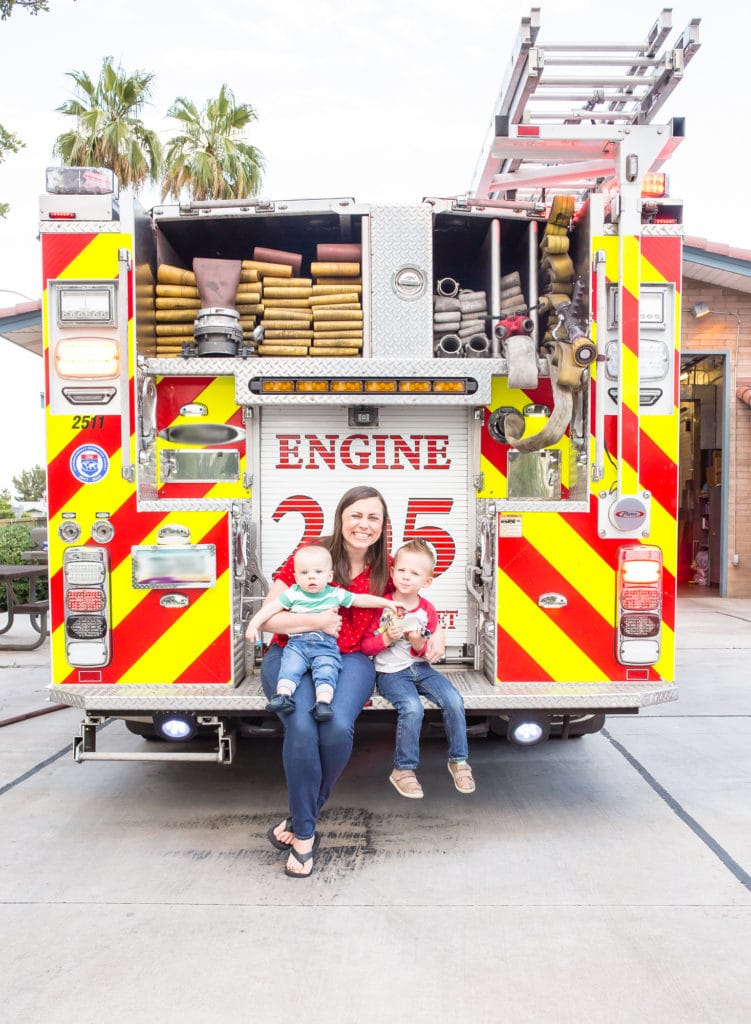
This is a paid promotion by Fisher-Price, and all opinions are my own. Thank you, Fisher-Price, for sending me these characters.
Summer vacation is here! It’s the first time my son has really been out of school and will now have to adjust to a summer schedule without as much structure. We’re feeling the need to plan some fun activities, outings, and mom-and-me dates to keep us both involved this summer!
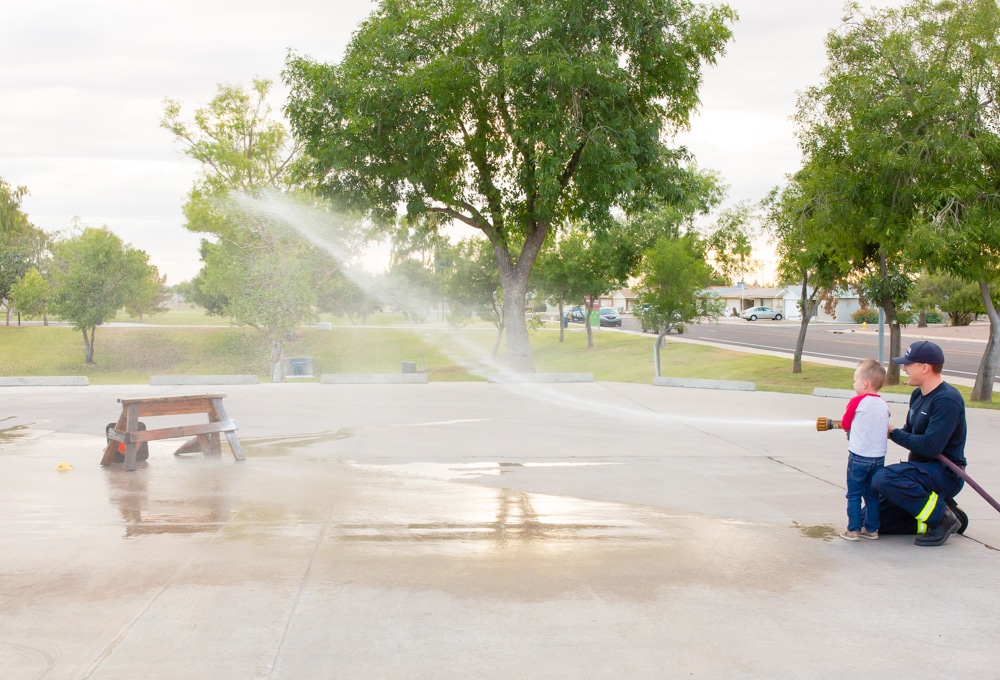
Fire Station Tours
A few months ago, I was invited to help chaperone a preschool field trip for my oldest child’s school and I jumped at the opportunity! Taking a group of very excited children to the local fire station and listening to the 3-year-old commentary sounded like a really joyful experience for the both of us!
He’s since been pointing out fire trucks, ambulances, and has been really into what they do! He’s even been dressing up and pretending like he’s a firefighter or a medic, and I love that he now knows who they are!
It really was a great experience, and we learned a lot. Unfortunately, the firefighters received a call just as it was time to show the kids the fire truck. Their little hearts were broken and some of the little boys even started to cry. It was a tragic, but yet, comical moment.
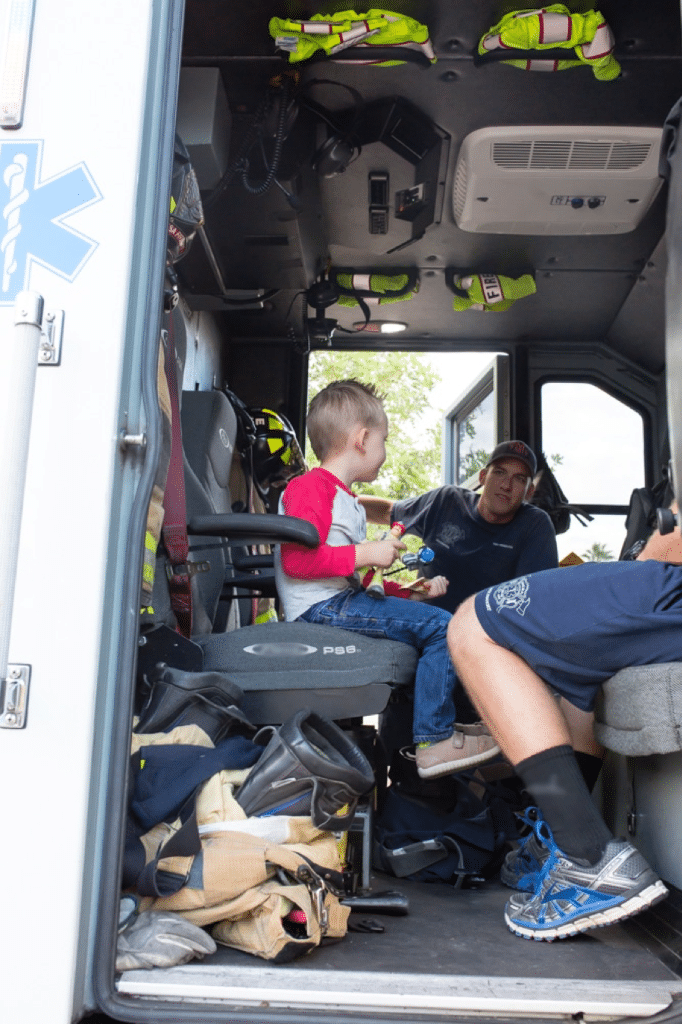
How to Visit a Fire Station
I learned that you can go with your kids to visit the fire station just about any time you want. You just need to call ahead and make sure it’s a good time for them! If it is, most stations are more than happy to give a tour, or at least let your kids see the trucks and try on a helmet. It’s free, it’s informative, and it’s exciting!
If you want to do a little more planning and have a more formal tour, check out your city’s fire department website. There is an easy form you can fill out that lets them know who is coming, the size of the group, and when you’d like to visit. It’s great if you bring a group!
Making a Fire Station Visit Even More Fun
To make your visit even more engaging, you can really make it memorable by including some toys for your kids to play with that truly help emulate real life, relatable heroes. Rescue Heroes from Fisher-Price aim to stimulate a child’s imagination and sense of adventure without using violence. Check out the new Rescue Heroes toys available at Walmart (available online now, in-stores in August!)
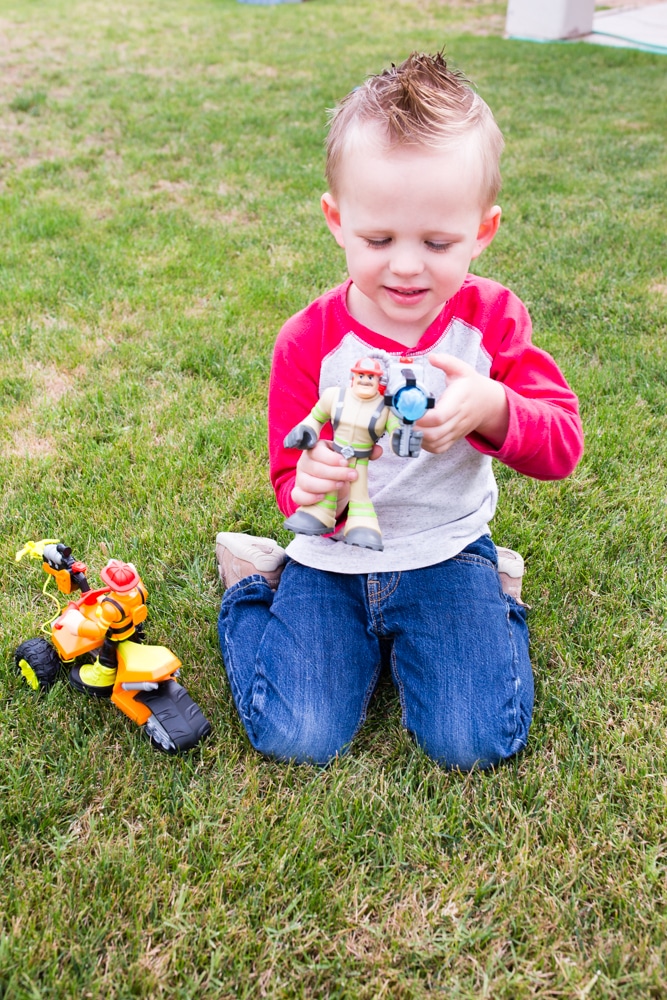
Rescue Heroes are relatable heroes for kids that represent a great diversity of genres, genders, nationalities, real professions and personalities that save the day! I love that they encourage no conflict play yet still promote excitement without violence. They demonstrate teamwork, a positive outlook, and make great role models. When you purchase Rescue Heroes toys, you get a great price value because it comes with a figurine, backpack and a super cool tool that you can interchange between characters.
The characters are all darling. But, the Billy Blazes figure, who is a firefighter and the team leader was the perfect character to introduce for this fun family outing to the fire station! We also love the Forrest Fuego figure, the hotshot wildfire firefighter, who can help and play as a team with Billy.

Honestly, we could easily duplicate this fun activity by visiting the police station with Sky Justice Police Recon and Rescue, or even go on a hike with Rocky Canyon the Mountain Ranger, and more. And if we wanted to add in a show, there’s a Rescue Heroes™ animated show on the Fisher-Price YouTube channel that showcases all of the characters!
Fire Station Visit
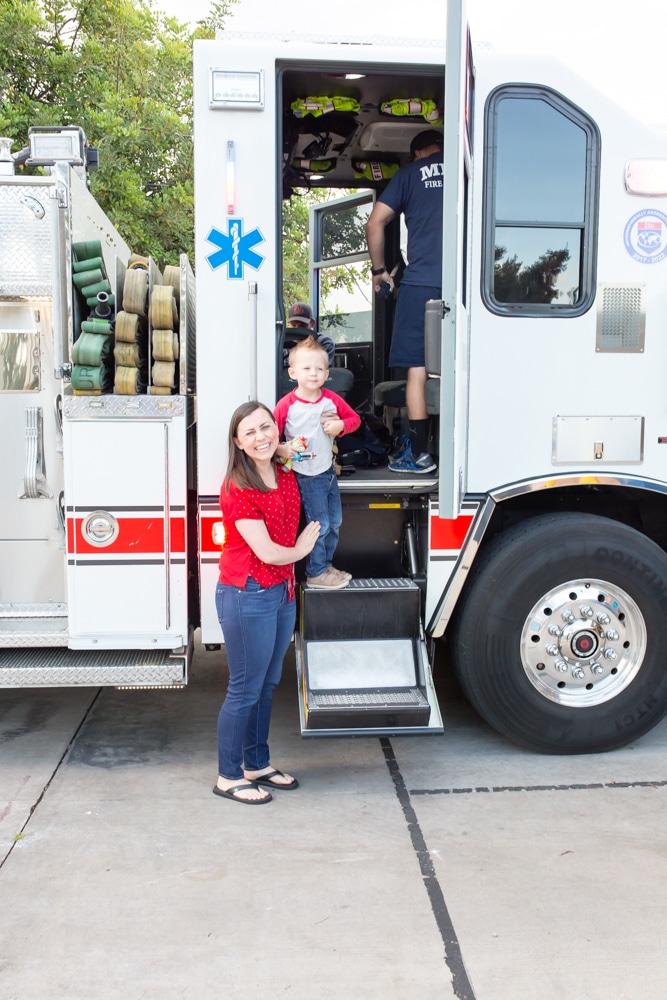
I am so grateful for first responders and all they do to help keep my community safe! I love that my son is so much more aware of what safety looks like. Additionally, that emergencies happen and that the men and women who come on those trucks and ambulances are here to help!
Fire Station Field Trip
It’s a fun thing to do as a school field trip. It’s fun to do as a mom-and-me date. Also, it’s an amazing family outing or family date you can do together.

I love that we can come home and he can play with Rescue Heroes. They are ideal personifications of real-world heroes from all over the Earth – daring, caring, skillful and strong.
Plus this mom-and-me date will be the highlight of at least one week, with fun role play time for him to enjoy long after our fun outing!
Get 365 Date Ideas!

We want to help you have the best date nights ever! Grab this FREE printable with 365 date ideas, a date for every day of the year so you never run out of ideas!
Success! Now check your email to find your free printable download!
There was an error submitting your subscription. Please try again.
Similar Posts

One of the Best Baby Shower Ideas
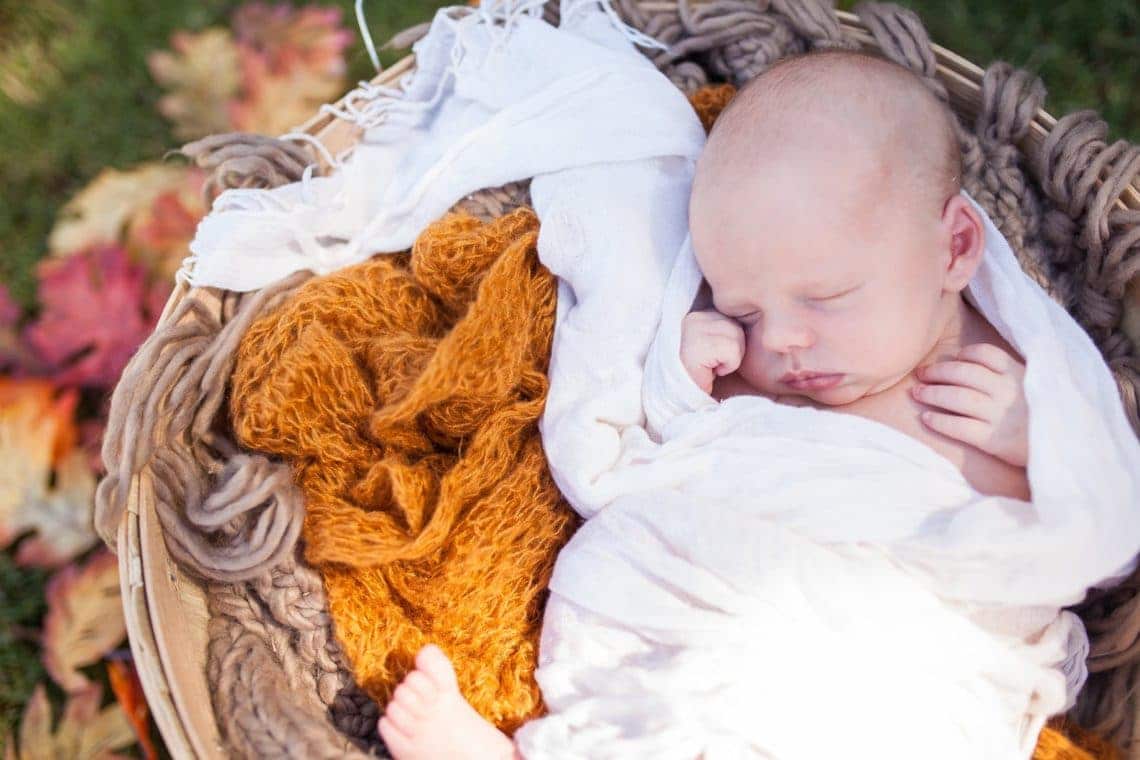
Newborn Photos: Part 2

Building Toys

Donut Grow Up 1st Birthday Party
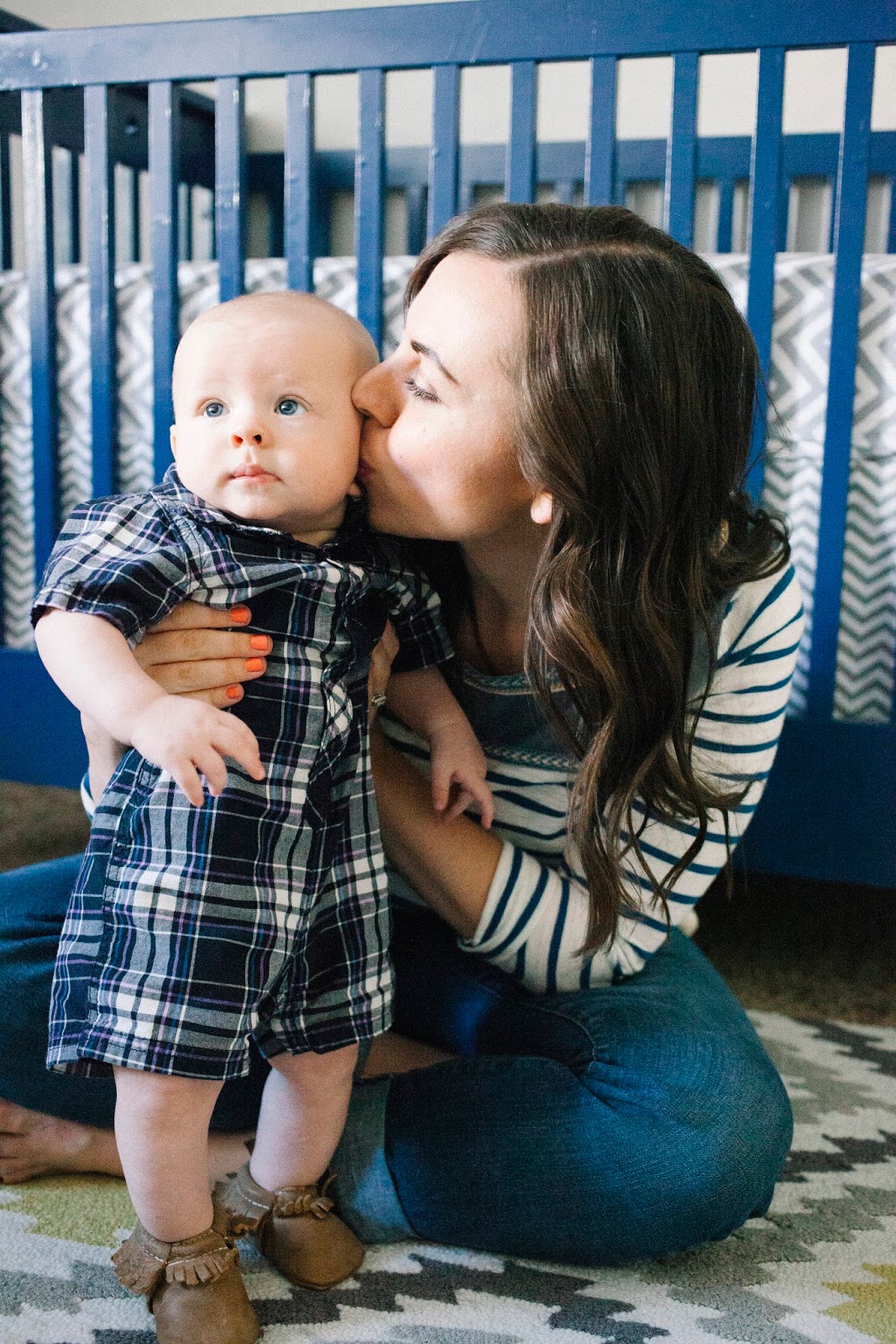
The Post I Never Thought I’d Write: Leaving Corporate America to be a SAHM

Annual Anniversary Pictures: Anniversary #6: Part 2
Leave a reply cancel reply.
Your email address will not be published. Required fields are marked *
How to Visit the Fire Station
Rhomylly forbes.

One of the most memorable field trips a child can go on is a visit to the local fire station. There's just something about seeing all the firefighting equipment up close, getting to touch the fire truck (and even maybe get to sit or stand on it) and getting to talk to a real firefighter that stays with a kid forever.
A trip to your local fire station is easy to arrange and can enhance your school's fire safety week curriculum.
Explore this article
- Schedule your visit
- Prepare for the visit
- Have an emergency plan
- Thank the firefighters
1 Schedule your visit
Schedule your visit. Call the fire station in advance and agree on a time for your Scout troop, class or church group to visit. You also can email the station to make the arrangements.
2 Prepare for the visit
Prepare for the visit. If you are taking a group of children to the fire station, help them think of some age-appropriate questions beforehand to ask the firefighters. Write down the questions and take them with you.
3 Have an emergency plan
Have an emergency plan. Make sure to discuss with your fire station contact in advance what you and your group should do in case an emergency vehicle needs to leave the station quickly during your visit. Practice what to do with your group before the visit.
4 Thank the firefighters
Thank the firefighters. After the visit, be sure to make a thank-you poster or individual thank-you cards from the children. Have an adult deliver the thank-yous to the station some time after the tour.
- If you want your group to visit the fire station in September, October or November, call in January or February to schedule the trip. October is Fire Prevention Month, and the schedule for fire station visits will fill up quickly that time of year.
- 1 Familyeducation.com: Fire Station Visit and Other Activities
Related Articles

How to Teach Kids About Ambulances

Rules for Tornado Drills in Daycares

Fun Homecoming Date Ideas

Safety Fair Ideas for Kids

How to Get a Police Escort

Hospital Themes for Preschoolers

Health Fair Booth Ideas

How to Treat Stomach Aches for a School Nurse

Youth Revival Ideas

How to Be a Good Church Usher

How to Respond to a Compliment From a Guy


How to Do a Fire Drill in My Home Daycare

"Week of the Young Child" Activities for Preschoolers

Proper Etiquette for Stopping by a Friend's House

How to Contact the Red Cross to Arrange for Emergency...

Ideas for Ladies' Ministry Events

Take Kids to Work Day Activities

The Best Romantic Surprises for a Girlfriend

How to Track APO Packages

Fun Ideas to Rekindle a Couple's Love
Regardless of how old we are, we never stop learning. Classroom is the educational resource for people of all ages. Whether you’re studying times tables or applying to college, Classroom has the answers.
- Accessibility
- Terms of Use
- Privacy Policy
- Copyright Policy
- Manage Preferences
© 2020 Leaf Group Ltd. / Leaf Group Media, All Rights Reserved. Based on the Word Net lexical database for the English Language. See disclaimer .
- Homework Help
- Article Directory
Local Field Trip: Fire Station
- /
- Math and Reading Help Blog
Firefighters hold a powerful mystique for many children. A trip to a local fire station can therefore be both exciting and educational, but there are several things to caution your child about before you go.
Before You Go
The first step in planning a field trip to a local fire station is to contact a station in your town to see if they perform tours. Many do, but a fire station is not the type of place where you can typically arrive without scheduling a visit first. You may find that only certain stations in your local area allow visitors and it may not be the one closest to your home.
Even with a scheduled visit, warn your child that firefighters are always at the mercy of an emergency call. You may arrive for your visit only to find the firefighters out on a call. If this happens, you'll likely need to reschedule.
Finally, it's also essential to warn your child that firefighters sometimes wear masks and other special equipment that may be scary. Remind your child that if a firefighter at the station you visit is dressed this way, it's only a person wearing firefighting clothes. It may help to discuss the purpose of potentially scary equipment; for example, describe how a gas mask helps firefighters breathe in smoke-filled spaces.
Teaching Moments at the Site
While touring a fire station, your child can learn about the different types of trucks firefighters use, including pumper trucks and ladder trucks. A firefighter may explain how the many tools that are stored on different trucks are used in fighting fires. Your child may also get to see the special clothes firefighters wear, including their heavy jackets, helmets and boots. In some cases, your child will be able to try on this equipment.
Some fire stations have a pole that enables firefighters to hurry from an upper level to the ground floor when an emergency arises. On some tours, your child may be able to try out the pole, though not every station allows this for safety reasons. Also, at some stations, your child may be able to try spraying water with a fire hose as a firefighter helps. What types of activities you'll be able to participate in will vary, so prepare your child for the possibility that not all of these opportunities will necessarily be possible.
After Your Visit
After visiting your local fire station, have your child keep an eye out for different types of fire trucks around your town. See if he or she can identify them and recall what role they play in fighting fires. In addition to spotting trucks driving around town, look for trucks being cleaned outside firehouses. You may also have your child draw pictures of what he or she saw and learned about at the fire station. This will help your child to retain the memories of this special trip.
Other Articles You May Be Interested In
We found 7 tutors you might be interested in, huntington learning.
- What Huntington Learning offers:
- Online and in-center tutoring
- One on one tutoring
- Every Huntington tutor is certified and trained extensively on the most effective teaching methods
- What K12 offers:
- Online tutoring
- Has a strong and effective partnership with public and private schools
- AdvancED-accredited corporation meeting the highest standards of educational management
Kaplan Kids
- What Kaplan Kids offers:
- Customized learning plans
- Real-Time Progress Reports track your child's progress
- What Kumon offers:
- In-center tutoring
- Individualized programs for your child
- Helps your child develop the skills and study habits needed to improve their academic performance
Sylvan Learning
- What Sylvan Learning offers:
- Sylvan tutors are certified teachers who provide personalized instruction
- Regular assessment and progress reports
Tutor Doctor
- What Tutor Doctor offers:
- In-Home tutoring
- One on one attention by the tutor
- Develops personlized programs by working with your child's existing homework
- What TutorVista offers:
- Student works one-on-one with a professional tutor
- Using the virtual whiteboard workspace to share problems, solutions and explanations
Find the Perfect Tutor
Our commitment to you, free help from teachers, free learning materials, helping disadvantaged youth, learning tools.
- Make learning fun with these online games!
- Looking for ways to bring learning home? Check out our blog.
Want to Help Your Child Learn?
More articles.
- How to Help Your Kids Discover Their Interest and Future Careers
- 10 Educational Rewards for Your Children
- 10 Summer Educational Trips You Should Take Your Kids On
- How to Prepare Your Kids for Starting a New Grade Level
- 5 Ways to Continue Your Child's Education During the Summer
- How to Help Your Child Read Above Their Grade-Level
- When Should Parents Opt Out of Their Child's Curriculum?
- Should Parents Give Their Preschoolers Homework?
- Getting Prepared for Homeschooling
- Mad Libs: A Fun Word Game That Teaches Nouns, Verbs, and Adjectives.
- Children's Math: Grades 3-8
- Attitudinal Healing
- College Survival Tips
- Making the Most of Reading to or with Your Children: Part 3--Grades K Through Three
- Homeschooling ADD and ADHD Children
- Requirements for Earning your GED
- The Values of an Allowance
- Common Behavioral Problems in Children
- Study Habits
- Get Help Early for a Learning Disabled Child
- Reading and Math Targeted by Miamis Teach for America
- Elementary Geometry Worksheets
- Algebra 1 Lessons Online
- Fourth Grade Reading Comprehension Examples
- Teaching Children Subtraction
- Privacy Policy
- Resource Directory
© 2003 - 2024 All other trademarks and copyrights are the property of their respective owners. All rights reserved.
Adventures with Twins, Cystic Fibrosis + a Food Allergy
Fire Safety Field Trip and Unit for Kindergarten and First Grade

Her eyes are gleaming as she steps up and grabs the fire hose. The fire fighter shows her how to turn it on and a gush of water swooshes out in front of her. She beams.
A field trip to the Fire Station never stops being cool. These are moments that no book, no picture, and not even a video can capture.
The uniforms. The hoses and levers. The bright shiny red trucks.
We have been lucky enough to go on several Fire Station trips in the different state we have lived and every time it is an awesome experience for my kids.

On one particular Fire Station visit my kids initially seemed a little less interested.
Our son climbed in the front and then out the other side. Our daughter started in the back and then hopped out. They both started wandering around the truck. I suggested we get our inevitable coloring books to speed along this process.
Then my son asked me, “What is this for?” He was pointing to one of the many switches on the side. I had no clue and I could see that he was curious, so I told him to ask a firefighter. He was a little unsure about this, but his sister bravely walked up to one of these large men and said “What does that do?”
The firefighter bent down and answered her question.
This led to another question and another. Soon they were following the firefighter around the truck as he demonstrated everything to them. Where the hoses were and how they got hooked up. What was inside the different compartments and what they used each item for.
Their questions were endless and his patience, seemingly, was as well.

We forgot about the heat. We forgot about needing water and wanting AC.
We learned a lot about firetrucks and then when they were done, they grabbed those coloring books and headed for the car full of ideas.
Safety Unit for Kindergarten + First Grade
Related curriculum or projects.
- Members of our community have different roles.
- There are community jobs to help keep everyone safe.
Before the Field Trip
- Talk to the Fire Station to confirm date and what to expect.
- Read some children’s books about Fire Fighters and Fire Stations. Here are our favorites: 10 Books about Firetrucks
- Talk to your kindergarteners or first graders about what they know about fire fighters and what questions do they have. Write these down on a chart, but also copy the list of questions onto paper to carry with you to the field trip.
During the Field Trip
You can absolutely just walk up to a station with a kid or two. If the fire fighters aren’t busy they are usually happy to show you their trucks.
However, if you plan ahead and call the fire station to set up a time the experience is definitely more in depth and fun. Fire Fighters are more than happy to have kids come for an educational field trip.
6 Tips for a Successful Fire Station Field Trip
1. read a book beforehand.
Read a book or two about fire fighters and fire trucks before you go. Looking at pictures of fire fighters in their gear might be helpful. Some of the children in our group were frightened by all of the gear, especially the face mask. Preparing your child beforehand by introducing them to what a firefighter wears and why might be helpful.
2. Bring a Camera
Bring a camera and take pictures. We spent a lot of time referring to the pictures of our trip in the weeks to follow.

3. Have a Bathroom Plan
If you have a child more recent to toileting, make sure to go to the bathroom beforehand. The bathroom at the firehouse is not usually set up for outside use, plus your kid is not likely going to be thrilled with a toilet break during the field trip excitment.
4. Prepare Your Child
Talk to your child beforehand about some of the things you might see. The fire trucks, the fire fighters. Older kids could also brainstorm questions that they want to ask the firefighters on your trip.
5. Talk about Expectation
I think this is a good idea anytime you go anywhere. Having clear behavior expectations and communicating them to your child improves the odds that you’ll get good behavior. My expectations at the fire station where that they would follow the fire fighters’ directions, use walking feet, and stay near me.
6. Go Again!
Like I said above, we’ve done this several times. We’ve gone with moms groups in each of the cities we have lived, taken advantage of fire trucks at festivals, and visited fire stations without a group. Kids need to be exposed to things more than once. Even though I typically only share each activity or place once, don’t be fooled – we do most things many, many times.
after the field trip
Now is the time to extend and deepen learning. First, print out your pictures from the field trip and post them where the children can see them and reflect on what they learned.
During a group time, add to your chart with the answers to your questions and write other things you learned at the station.
Have new questions arisen? How could you go about answering those.
Use this conversation to help direct where you go next. What interested them the most? What are they wondering about?
Below are some Fire Fighter Unit ideas we have used.
Literacy Activities
- Draw and/or write a family or classroom emergency plan.

- Comparing and Contrasting Fiction and Non-Fiction Books
Art Activities
- Paint Fire and then pretend to put it out with play hoses.
STEM Activities

- Make a Rescue Vehicle STEM Invitation
- Drawing signs shape activity – based on the goal to build and draw shapes to possess defining attributes. For example, a triangle is a closed shape with 3 sides and 3 corners)
- Five Little Firefighters (Craft + Song) from JDaniel4’s Mom
Social Studies Activities
- Things that work on social studies goals of understanding that people in the community have jobs, use tools to provide services, help in emergencies, and are diverse and work together.
- STOP, DROP AND ROLL (Song) from Rubber Boots and Elf Shoes
- Set up a dramatic play center using fire fighter costumes ( we used these ) and the DIY Pretend Play Fire Hoses described below.
- Add pretend fire trucks to your block area and perhaps some construction paper “fire”

DIY Pretend Play Fire Hoses
- Tape (I used craft tape and painters tape )
- 1/2 Inch Self Adhesive Weatherstrip Directions: 1. Gather materials 2. Cut the insulation to the desired length. I made two of these, one for each of my kids. If you are making them for a larger group, I recommend at least 4. 3. Cut lengths of painters tape and fold each strip in half to make the “water” 4. Tuck the painters tape into the insulation and use tape to wrap it shut. I used colorful tape of two different colors to distinguish which hose belonged to which child. Masking tape would have worked just as well to hold it together. 5. Coil and place in a basket on the shelf for play time.
Current Learning Objectives
Examples of what is learned through the activities in this unit based on NYC Common Core Standards for First Grade.
- People in the community have different jobs. (Social Studies)
- Community workers use tools and resources to provide services in a community. (Social Studies)
- People in a community help their neighbors in emergencies. (Social Studies)
- Community workers are diverse and work with one another. (Social Studies)
- Build and draw shapes to possess defining attributes. (Math)
- Compare and contrast fiction and non-fiction. (Literacy)
- Understand parts of informational texts. (Literacy)
- Understand features of a sentence and write various forms of texts. (Literacy)

Subscribe Below for Weekly Field Trip & Unit Ideas
Share this:.
- Click to share on Twitter (Opens in new window)
- Click to share on Facebook (Opens in new window)
- Click to share on Pinterest (Opens in new window)
- Kale by LyraThemes.com.
5 Family Activities you must do at the Fire Station
Save it, Share it, Send it!
Post Preview: Firefighters know they need to focus on their mental health, but what about their Family’s? These activities at the Fire Station can help nature positive family relationships.
Firefighters are really big when it comes to family, after all, it is a family tradition.
Working in the fire service is one of those things that sometimes takes away from family time. Like many other worthwhile careers, Firefighters have to sacrifice some time away to work and improve their skills.
My Firefighter and I make it a priority to spend time together on and off shift. We are doing what we can to help all of us have good mental health and low levels of stress. Check out 5 easy ways you can do this below!
Why does Family Time matter for Mental Health?
Often times we talk about doing things as a family and then… well… life happens! Plans get changed, somebody is sick, somebody else is grumpy. I know that I’ve had days where we just turn the car around and go home!
But Family time, especially positive family time has a huge impact on the stress levels of everyone. Not only does spending quality time reduce stress levels but it also builds healthy relationships with your kids . Many studies are now showing that children that don’t receive quality time with the family unit are at higher risk of emotional and behavioral disorders.
The U.S. Department of Health and Human Services Substance Abuse and Mental Health Administration has a program called “Building Blocks for a Healthy Future”. Quality family time is vital in that program for healthy development and can lead to better choices in the future when it comes to abuse or poor decision making.
By spending time together, Your child will get to model your behavior, develop better communication, voice their thoughts and feelings, and get to experience loving relationships. That’s just the tip of the iceberg! There is so much to be gained when you make a concentrated effort to have everyone together.
And honestly, if your family (first or second) is in a good place mentally, it makes things so much easier for you!
What if you can’t visit?
Some people will say that they aren’t allowed to visit their firefighter. To that I say, BS. Family is the foundation of the fire service, so have your firefighter talk with others and the chain of command to see how it can be arranged for family to have time to visit.
I know for our station, it’s highly discouraged to come by during working hours from 8-5 (and sometimes later just depending on what they tasks are that day). So we don’t visit a lot during the week and try to make plans to see him on the weekend after his list of duties is done.
That is compromise and it works well for our family.
I do understand that there are many stages to the fire service, some are in military, some are hotshots, some are volunteers . Those all look different- but that doesn’t mean that you can’t set aside a special visit to see where your firefighter works.
If it is really unavailable for you to visit (due to sickness, danger, or location) make it a priority to video chat. It’s important to have visuals so you can understand where your Firefighter spends his time and for everyone’s mental health.
The Activities at the Fire Station
So you know that family time is important and you have a time set up to see your firefighter. But what do you do at your visit? Do you sit around and just chit chat? Sure. But if you have kids, you are going to want to keep them entertained somehow!
Here’s my list of favorite ideas that build those family relationship- and the kids don’t even know it.
- Wash the truck (or something else like a golf cart that won’t get damaged)
This is one of the all time favorite things for us to do, and other firefighters at the station love to do it with their family as well. This is one of those chores turned family time type things that allows for a clean apparatus and a happy family!
Our kids love to wash the truck, but we also have several other vehicles they can wash so that damage doesn’t accidentally happen.
2. Cook dinner together (or bring dinner)
Food, YUM! Everyone loves food. Theres’ nothing like getting together with your firefighter and his second work family over a meal.
Cooking food is a great option, but I do understand that some stations are really busy! In that case, decide if its better to bring food in or have someone who isn’t the firefighter in charge of cooking.
3. Have a Pajama party
Lots of people live far away from their firefighters work zone, so coordinating schedules can be hard with school and other family members jobs. Especially when you have kids Cue the Pajama party!
Get the kids home from school, feed them and put them in their Pjs. Drive to see your Firefighter and then, when they *hopefully* fall asleep on the way home, you can just put them in bed. Thats a win/win in my book!
4. Participate in a parade or community event
This may seem like a no brainer- but if you don’t plan ahead you are likely to forget. I cant tell you the number of times my firefighter would spring an event on me last minute. (I took matters into my own hands and got a calendar!)
Going to an event where your firefighter works can be a lot of fun but you do run the risk that they are busy! We try to weigh it out ahead of time based on how the event was last year or what the event is for. Chances are, my firefighter will have a good 10 minutes to hang out and sometimes he’s had even more time!
He doesn’t work all the events though, so sometimes we visit him because its a family event. This could also be anything from a charity that they get together to support to a holiday event.
These types of activities are the perfect ways to get involved with your firefighter because family is expected to come. So if you suffer from some anxiety about stopping by during shift time, this is the perfect time to do it!
5. Have breakfast together
We already know that firefighters love food, so a super fun way to spend time at the station is with breakfast! The cool thing about breakfast is that it can be done before, during or after shift.
WIth such a versatile time frame this is a fun activity that can be low key and low stress. Just grab some pancake mix and syrup or bacon and eggs. My personal favorite is muffins since I can bring enough for everyone and not have to worry about clean up.
Enjoy your breakfast, have some coffee and hang out at the station. This is the perfect Saturday morning if you ask me!
Bonus Tip! If possible, do a movie night at the station. This will require some planning since you want to schedule this on a “ low call volume” day (which can be hard! I know). But if you are able to do it, think about how much fun it would be! Even if they do get a call, you can leave the kiddos watching the movie and then catch up with your firefighter gets back to the station.
And these ideas don’t even cover all of it. Where theres a will, theres a way! Family time should be protected.
The Importance of Work Life Balance
There has been a lot of talk about Firefighters and mental health. Part of that discussion is asking difficult questions like, “Do I work too much as a firefighter?” “Am I getting enough family time” “How do I control my stress levels?”.

When you have an appropriate amount of work time balanced with the appropriate amount of regular life, you are able to manage your feelings and stress levels better. You feel better. You sleep better. You can “turn off work and leave it at work”, NOT bring it home.
Spending time with family, especially healthy time where you are actively engaged, can significantly improve mental health – which means you will be less angry, less anxious and less likely to snap at someone.
Working too much- especially in a high trauma arena as a first responder is stressful. We all know that higher levels of stress have a negative impact on firefighters.
Work Life Balance is so incredibly important for firefighters. We all assume that because they work different hour shifts or that they volunteer that work life balance doesn’t matter. But I’m here to tell you that it does in every professional sense (Degree in Human Resources) and personal sense (married to a firefighter).
Find a balance, find time on shift for family, and see the benefits it adds to your life.

Family Time is so important! Even if your firefighter has a crazy schedule you can find ways to make it work so that the kids can get the best of both worlds. Plus, the benefits to mental health for the entire family can’t be overlooked, especially with something as fun as spending time together.
Kids are never going to remember their best day of TV, they will remember all the times they got to spend at the station and do fun activities with their firefighter!
Tell me Fire Family, do you have any other activities to recommend? Did you try any of these at the station ?


Fire Station Visit
FunShine Express Curriculum
Children enjoy a visit from the fire department to reinforce fire safety.
What you'll need
- coloring tools
Step by step
Most fire departments have materials and outreach staff to teach young children about fire safety. Contact your local fire department ahead of time and inquire about whether a visit to the station is possible. If it would be difficult to take a field trip with your group, ask if they have staff available to visit your setting.
If children are involved in a real fire emergency, they will likely have contact with a firefighter dressed in full attire. Often, firefighters' faces are covered and they may carry big tools. When sirens, smoke, and bright lights are added, children can become very frightened. This activity provides an opportunity to introduce children to actual firefighters and their equipment.
Ask the firefighters to show the children their protective gear and explain why they wear each item. Ask them to speak through the face shield so children can hear how they may sound in an emergency situation. Encourage children to ask questions about what firefighters do when they are on duty and the tools they use. Some departments may be willing to let children sit in an emergency vehicle.
After the visit, encourage children to help you write a thank you note to the fire department. It is important to thank firefighters for helping in the community. Do any of the children think they would like to be a firefighter when they grow up? Why or why not?
Learning outcomes
Social Studies
Geography and Symbolic Representation
Describes characteristics of things in the environment at school and home; builds roads and houses using blocks; begins to represent people, places, and things through drawings, movements, and construction across learning domains
Describes geography of places (home, school, community); identifies familiar symbols and landmarks (US flag, globe); creates drawings, makes simple maps, and builds structures to represent people, places, and things; begins to learn phone number and address
Culture, Family, and Community
Recognizes and identifies some community helpers, parents' jobs, and careers; adopts roles of family and community helpers during dramatic play with realistic props
Identifies and describes the roles of a variety of community helpers, parents' jobs, and careers; adopts wide variety of family and community helper roles during dramatic play
Physical Development and Health
Safety Awareness and Self-Care
Recognizes and avoids potentially harmful items and situations with guidance; begins to follow basic safety and health rules
Identifies and alerts others to potentially harmful items, behaviors, situations with guidance; identifies and follows basic safety and health rules
Approaches to Learning
Curiosity, Initiative, and Risk-Taking
Shows a willingness to participate; shows eagerness to join play events, experiments, and exploring activities; tries new activities independently
Welcomes play experiences and shows creativity and inventiveness; demonstrates inquisitiveness about subjects and objects
Creative Thinking, Problem-Solving, Reasoning
Asks more complex questions for clarification to seek meaningful information; makes comparisons among objects and groups; explores cause/effect relationships and varies action to change the reaction
Gathers information and asks complex questions in order to understand a new or familiar concept or to conduct informal research; makes and explains comparisons among objects and groups and uses "if/then" and "cause/effect" reasoning across learning domains
To leave a comment please sign up or log in

- Course Registrations
- FREQUENTLY ASKED QUESTIONS
- Comprehensive Courses
- KidVision Pre-K Program
- Micro Courses
- Guided PLCs
KidVision Virtual Field Trip: A Trip to the Fire Department
Virtual Field Trip Description
Early childhood educators use this program to deliver standards-based learning experiences that spark children’s imaginations and nurture their curiosity about their community and future careers. Join Penny and the KidVision Program on this educational adventure!
Through a blend of immersive, interactive videos, lessons, assessments, and take-home resources, early childhood educators deliver standards-based learning experiences that ignite children’s imaginations and foster their curiosity about community and careers.
Our KidVision Virtual Field Trips are designed to inspire and educate young minds about the world around them, exposing children to potential career paths and introducing and building essential vocabulary. Don’t let budgets or travel restrictions hold your child back – join us on our exciting virtual field trips today!
Each Field Trip Includes
Preschool-themed virtual field trip videos that provide a look into community-based organizations. Teachers will use these materials as a source for their own professional development as well as a supplemental curriculum for their students in the classroom.
Age specific, standards-based lesson plans and assessments, which include alignment to state-specific early learning standards and the Head Start Early Learning Outcomes Framework. Lesson plans target the following age groups: 4YO, 3YO, 2YO, 1YO. Available in both English and Spanish. Field Trip
KidVision Program Benefits
KidVision Virtual Field Trips open a world of community, career, and unique learning experiences from the comfort and safety of the classroom. Our trips eliminate the need for expensive transportation, chaperones, and the liability associated with traditional field trips.
KidVision Virtual Field Trips align with early learning standards and include instructional resources that seamlessly integrate into your preschool curriculum so students can participate in multiple trips throughout the year.
Take Home Pages in both English and Spanish, which include structured reinforcement activities to be completed at home with family members in support of the language, communication, and emergent literacy skills addressed in class.
Each Virtual Field Trip Experience includes extension activities focusing on building vocabulary and/or additional theme-related “A Day With” videos which will enable children to shadow a day in the life of a professional as they describe the details of their job.
Structured teacher reflection activities and discussion forums with peers locally and nationally.
Teachers will earn 5 in-service hours .5 CEUs (e. Continuing Education Units) for each completed Virtual Field Trip Experience. In-service hours can be used toward the renewal of CDA (Child Development Associates) credential. Continuing Education Units are accredited through the International Accreditations for Continuing Education and Training (IACET).
Teachers will receive certificates of completion upon the successful completion of their KidVision Field Trip Experience and have the ability to download a transcript that includes all completed field trips.

Danielson Teacher Framework Course Alignment
Demonstrating Knowledge of Resources
Using questioning and discussion techniques, engaging students in learning, demonstrating flexibility and responsiveness.
Categories: KidVision Virtual Field Trip Program
Touring Your Local Fire Station
October 1, 2011

It’s October and that means pumpkins, candy and bringing in the harvest. October is also Fire Safety Month. Read on for tips to plan a visit to your local fire station.
- Call ahead to schedule a visit.
- Call once more on the date of your visit as firefighters’ schedules are unpredictable.
- Bring your camera.
Before You Go
Calling ahead is a must before you visit any fire station. Some cities, such as Olathe and Lee’s Summit, require a 2-week advance notice for a tour. Typically, you can do this either with a phone call or an online request. You’ll want to call again before you head to the station on the day of your visit. You never know when the firefighters will need to respond to a call. That’s why you also need to have a back-up plan. Find a park, library or indoor play area near the fire station. If your tour is canceled, you’ll know just what to do!
While You’re There
Each station is different, but you’ll likely have one of the firefighters lead the tour. This might include viewing the office, bunk and dining areas, in addition to the trucks and equipment. If your children are younger, consider respectfully asking to see the trucks first. Don’t be surprised if your children have the opportunity to sit in the truck and even try on some of the gear. Your kids are sure to be delighted—so take pictures! Then, hand your older children the camera so they can capture some pictures to share with their friends.
When You Get Home
After you get home, why not have your children make thank you notes for the firefighters at the station you visited? It’s a great way to teach children to be thankful for community helpers. You might find that your children still have questions about the station tour. If so, encourage them research to find answers. Older children will benefit from applying research skills they’ve learned in school. Of course, if you don’t already have a family fire escape plan, now is the time to create one. Visit a site such as www.FireSafety.gov for tips on keeping your family safe.
Elizabeth Welter lives in Olathe and loves taking her three young kids on fun outings.
Subscribe to KC Parent's Weekend Fun Guide!
Powered by Robly ™
Family Media Group. All rights reserved.

Fire Department
Sudbury, Massachusetts
To use navigation menus, please switch to desktop mode or enable JavaScript.
- Town Officials
- State and Federal Representatives
- Election Results Archive
- Telephone Directory
- Sudbury MapsOnline
- Historic Maps
- Conservation Land Maps
- Precinct Map
- Zoning and Buildout Maps
- Sudbury Community Profile
- Sudbury Trust Funds (PDF)
- Community Preservation Act Information
- Around Town (Activities)
- Media Galleries
- Seasonal Images
- Town Meeting Recordings
- Sudbury Public Access Programming
- Historic Districts Commission
- Historical Commission
- Historical Society
- Historic Articles (Informational)
- Historic Sudbury Driving Tour
- Town Calendar
- Goodnow Library
- Senior Center
- Camp Sewataro
- K-8 School Events
- Lincoln-Sudbury Regional High School Events
- Local (Channel 8/31) Programming
- Sudbury Public Schools (K-8)
- Lincoln-Sudbury Regional High School
- Application for Appointment
- Agricultural Commission
- Board of Assessors
- Board of Health
- Board of Registrars
- Cable Advisor
- Capital Improvement Advisory Committee
- Commission on Disability
- Community Preservation Committee
- Conservation Commission
- Council on Aging
- Cultural Council
- Design Review Board
- Diversity, Equity and Inclusion Commission
- Earth Removal Board
- Energy and Sustainability Committee
- Finance Committee
- Goodnow Library Trustees
- Land Acquisition Review Committee
- Lincoln-Sudbury Regional High School Committee
- Community Emergency Response Team
- Medical Reserve Corps Executive Committee
- Memorial Day Committee
- Park and Recreation Commission
- Permanent Building Committee
- Planning Board
- Ponds and Waterways Committee
- Rail Trails Advisory Committee
- Route 20 Sewer Steering Committee
- Policies and Procedures Review
- Sewataro Assessment and Recommendations
- September 11 Memorial Garden Oversight Committee
- Sudbury 250 Committee
- Sudbury Housing Authority
- Sudbury Housing Trust
- Sudbury School Committee
- Town Moderator
- Traffic Safety Coordinating Committee
- Transportation Committee
- Veterans’ Advisory Committee
- Zoning Board of Appeals
- Archived Committee Listing
- Assessors Office
- Building Department
- Conservation Office
- Cemetery Department
- Engineering Department
- Highway Department
- Parks and Grounds Department
- Transfer Station / Recycling Center
- Dog and Animal Control
- Facilities Department
- Accounting Department
- Collector / Treasurer
- Board of Health Nurse
- Social Worker
- Human Resources
- Information Systems
- Lincoln-Sudbury Credit Union
- Park & Recreation / Atkinson Pool
- Planning & Community Development
- Police Department
- Select Board’s Office
- Curtis Middle School
- Haynes Elementary School
- Loring Elementary School
- Nixon Elementary School
- Noyes Elementary School
- Informational – Historic Articles
- Town Manager
- Veterans’ Agent
- Lincoln-Sudbury Adult Education
- Dog Licensing
- Online Tax Payments
- Pay Delinquent Excise to Deputy Collector
- Parking Ticket Payments
- Vital Records
- Email Groups
- Website Content Updates
- X (formerly Twitter)
- Content Updates
- Black Powder Storage
- Blasting Permits
- Burial Permits
- Burning Permits
- Daily Registration for Outdoor Burning
- Fire Station Rte 20 Construction
- Fire Radio “Live Audio Feed”
- Fire Department Apparatus
- Hazard Mitigation Plan
Can I bring my children to visit the fire station?
Faq categories.
- Email this FAQ
- Print this FAQ
- Back to Fire Department
- Skip to main content
- Skip to secondary menu
- Skip to primary sidebar
- Skip to secondary sidebar
- Skip to footer

- Grapevine Magazine
Importance of Family Station Visits
October 1, 2019
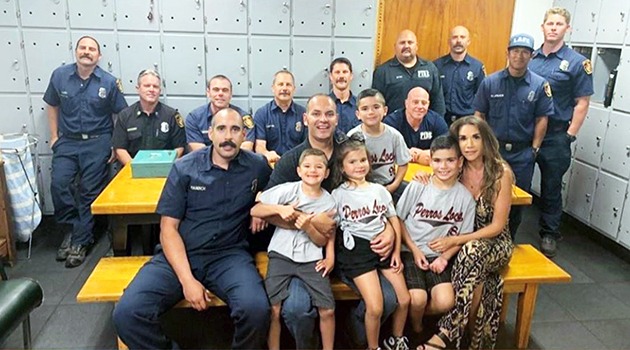
A visit to the station may seem inconsequential at the time, but I promise you, it’s not. It is a memory your children will talk about for the rest of their lives, and it is a chance for you and your spouse to reconnect and remember why they are there in the first place. We are thankful and grateful to the LAFD for the opportunity of allowing us spouses and kids to visit.
I look forward to seeing your updated pics on Instagram @housewivesoflafd .
Keep the flame alive!
Bonnie Lopez
Main Office Numbers (800) 244-3439 Toll-free (323) 259-5200 Direct
Office Location 7470 N. Figueroa St Los Angeles, CA 90041
- Staff Directory
- Board of Trustees
- Privacy Policy
Give To A Hero
Widows, orphans & disabled firefighter’s fund.

Child rescued after getting stuck in chimney

WHITMAN, Mass. (Gray News) - A 10-year-old boy was rescued after getting stuck in a chimney.
On April 10, Whitman Fire Department said it responded to a 911 call about a 10-year-old child who had climbed out of a second-floor window and into the chimney of his home.
Firefighters used a ladder to access the roof where the child was stuck in the top of the chimney from the waist down, according to the fire department.
Firefighters quickly removed the child, who was not injured, according to officials.
Copyright 2024 Gray Media Group, Inc. All rights reserved.

Gulf Coast Jam organizers announce new music festival

New mayor elected in Panama City Beach

School bus crash in Walton County

Sneads High School softball coach arrested in Jackson County

Mexico Beach mayor voted out of office
Latest news.

Law enforcement officials in 4 states report temporary 911 outages

Jury selection in Trump hush money trial faces pivotal stretch as former president returns to court

Biden is trying to win back young voters

Katy Perry explains why she is leaving ‘American Idol’

Katy Perry breaks top on live television

How to set up an Amazon Fire Kids tablet for your child
Quick links, how to set up your amazon fire kids tablet, how to manage screen time and available content on a fire kids tablet, how to add apps and content to amazon kids, what is amazon kids+, which amazon fire kids tablet should you buy, more amazon fire kids tablet faq.
- Amazon Fire Kids tablets are built to be durable, affordable, and have parental controls for a child-friendly experience.
- Parents can set up their child's profile, including a lock screen pin and content restrictions, through the Amazon Parent Dashboard.
- Amazon Kids+ subscription provides curated age-appropriate content for children, allowing them to access books, apps, videos, and web content.
Kids love tablets. Between access to a library worth of books, all their favorite shows and movies, and interactive games, it's easy to see why tablets have become such a popular device for kids.
Of course, you might not want your kid using your own tablet for a litany of reasons, which is where the Amazon Fire Kids series of tablets saves the day. They're built to take a beating, have a suite of features designed to entertain and protect your child, and cost a lot less than an iPad or other high-end tablets. But getting a Fire tablet for your kid comes with lots of questions, like which one is right for you and your family?
Also, how do the parental controls work? We've rounded up everything you need to know about Amazon 's Fire Kids tablets in this guide.
Best Amazon Fire tablets: Which Amazon tablet should you buy?
If it's the first time opening your Fire tablet, you'll be prompted by the usual set-up steps, like selecting which language you'd like to use and setting up your internet connection. From there, you'll be prompted to set up your Fire Tablet by logging into your Amazon account. It's important you use your own Amazon account. Don't create a new account for your child, that will come later. Here's a step-by-step breakdown.
- Log in to your Amazon account or create a new one.
- Set a lock screen pin . This can be used to safeguard inappropriate apps and prevent your child from making purchases.
- Set up your child's profile . It will be added to your Amazon profile, giving you access to a suite of parental controls.
Once you've added your child to the tablet, you can set up the parental controls in the settings menu or through Amazon's Parent Dashboard on your phone or laptop. There are handy features that let you easily control screen time and adjust what age range of content your child will see.
Once your child's profile is set up on the Fire tablet, you can control their screen time and what content through the Amazon Parent Dashboard.
Once you've added your child's profile to a tablet, the Parent Dashboard will work on any of your devices, allowing you to set all types of preferences and content guidelines for your child's new devices. You can do more than just control screen time, but also set educational goals centered around the amount of time they can read or listen to books versus watching videos.
- Click the profile icon at the top right.
- Select time limits .
- Select your profile and enter your pin code.
- This will open the Daily Goals and Time Limits menu where you can set time limits, turn the device on and off, set educational goals, and select which content you'd like available to them.
To keep your child's tablet fresh and engaging, you'll often need to add new books, apps, and games. The Amazon Kids Dashboard simplifies this by giving you complete control over what gets added to your child's profile. Your kids can request apps, but they won't get access until you review and approve them. This not only keeps inappropriate content at bay but also ensures they don't make any purchases without your knowledge.
Find apps or games
Amazon's selection is vast, offering plenty of options to enrich your kids' profiles. For starters, PBS Kids is a fantastic app choice. It's packed with free content from beloved shows like Sesame Street, not to mention a bunch of fun, educational games. And if your child loves creativity, the Amazon app store is brimming with coloring book apps. These are great because they often feature characters from popular children's movies and shows, so you can always find something that matches your kid's current obsession.
You can also add videos from your Amazon account. For instance, my daughter adores the Trolls movies, so I've added them to her profile. This means she can watch them during her screen time, and thanks to the Fire Kids tablet, I've been spared from endless reruns -- though I must admit, I've still seen Trolls Band Together more times than I can count.
It's easy enough to add content, but you have to follow these steps:
- In the adult profile, head to Amazon Apps and find the app or game you want, download and install it.
- Open the Amazon Kids Dashboard app, and select content from the menu on the left.
- Tap " Amazon Content " and you'll see any apps, books, videos, audible content, or Alexa skills you've added to your adult Amazon account.
- Select the apps or content you want to add.
- Sign back into the child's profile to access the app or content .
The Amazon Fire Kids tablet comes with some pre-installed content, but as your children grow, you might want to add more. You have the control to allow access to additional apps and games, enabling you to decide what your child is exposed to, in addition to Amazon's built-in protection.
Parental controls within apps
It's important to remember that if you install external apps like movie streaming services, you'll need to set up parental controls within those apps separately. The Fire tablet's parental controls do not extend to third-party applications. You also have the option to add specific websites or web videos, tailoring content to your child's interests. This could include educational websites or selected YouTube content , without granting unrestricted access to all of YouTube. Keep in mind, however, that adding these resources is a manual process and might require some time.
Best Fire tablet apps for kids: Video streaming, games, and educational apps
Amazon Kids+ is a subscription service from Amazon loaded with content for kids. It was previously called Fire for Kids Unlimited, or FreeTime Unlimited. As we've mentioned, this is a service that comes free for one-year with the Fire Kids Edition tablet, but you can also subscribe to it separately if you'd rather buy the standard tablet.
Amazon restructured the pricing in June 2022, so there's one price for Prime subscribers and one for non-Prime subscribers. The option for a single child has been removed, and now all subscribers can have up to four children using a subscription. There are options for monthly or yearly subscriptions. Amazon also offers a free one-month trial, if you want to give it a go.
Amazon Kids+ provides a few benefits over the regular Amazon Kids offering that comes with all Fire tablets. Amazon curates content and makes it available to children through the Fire tablet, so that they have access to age-appropriate books, apps, videos and web content.
How to expand your Amazon Fire tablet storage with a microSD card
This opens up the range of content that's available to children, allowing them to make some additional selections, like accessing more books, without parental intervention. Unlike the content you might assign, this is all verified as appropriate by Amazon. You retain the ability to add more content, as above, if you want to.
The Amazon Kids+ content is broken down into different age ranges, something that you can choose from the child's profile, and if you have older children who want more content, opting for Unlimited is a good way of knowing they have access to content without constant requests to buy or grant access to more stuff.
Whether you think that Amazon Kids+ is worth it will very much come down to how much content you think your kids need, and whether you think the subscription will outweigh the amount you spend on buying fresh content for them.
Amazon sells a few different versions of its Fire tablet: the Fire HD 10, Fire HD 8, and the Fire 7. Each Fire Tablet also features a Kids, and a Kids Pro model that includes a built-in protective shell and a year-long subscription to Amazon Kids+. All the Fire Kids Pro tablets are made for six to 12-year-old kids, while the regular kids tablets are made for three to seven-year-old children.
Best kids tablet: Parent approved and reviewed
Choosing the best option for your family really comes down to the age of your child and how much you trust them to take care of a tablet.
The first decision you'll need to make is whether you want one of Amazon's Kids Fire tablets that includes a protective shell and a year-long subscription to Amazon Kids+. Pocket-lint's choice for the best tablet for kids is the 2023 model of the Amazon Fire HD 10 Kids, as it features all the bells and whistles a Fire Kids tablet can offer. If your child is a little older and doesn't need a protective shell, then we recommend the Amazon Fire HD 8. It's our choice for the best Amazon Fire tablet overall , because of its amazing performance packed into an affordable price.
Amazon Fire HD 10 Kids (2023)
Best Fire tablet with a protective case
The Amazon Fire HD Kids Pro was already a great tablet for kids, and the updated 2023 edition is even better as it's 25% faster and has an improved 13 hours of battery life. It also comes with a year's subscription to Amazon Kids+, which has a wide range of age-appropriate apps, games, and videos.
Amazon Fire 8 HD
Best Fire tablet without a case
The latest version of the Amazon Fire 8 HD features 13 hours of battery life and is up to 30% faster than previous models. It comes in two different storage options to choose from: 32GB and 64GB.
The Fire HD 10 Kids Pro tablet, features a 10-inch HD display and is on the more expensive side of the Fire tablet spectrum, while the Fire HD 8 has an 8-inch display and is a mid-tier price option. Whether you'd like to save money or get your child the best possible display, Amazon has Fire tablet options to suit your needs.
All the Amazon Fire models run on the same user interface and offer the same software features, including all the controls you need to make it safe for your kids. This is an advantage over regular Android tablets, and it's substantially cheaper than an Apple iPad, although if you've bought a lot of iTunes content or have iOS-specific apps in mind, that might be a barrier to your choices.
What's the difference between the Amazon Parent Dashboard and the Amazon Kids Dashboard?
Amazon's Parent Dashboard is for parents to monitor and manage their children's activities on Amazon devices and services. It allows parents to view activity reports, set educational goals, manage content, and control screen time. The Parent Dashboard is typically accessed through a web browser at the Amazon website or through the settings on your Amazon device.
Amazon Kids Dashboard is part of the Amazon Kids (formerly FreeTime) interface on Amazon devices like the Fire Kids tablets. It's designed for children to use and provides a kid-friendly environment with access to approved content like books, videos, apps, and games. Parents can customize this dashboard through the Parent Dashboard to ensure it's age-appropriate. The Kids Dashboard is directly accessible on the Amazon device, usually via the Amazon Kids app or a dedicated section on the device's home screen.
How do I create a child profile on the Amazon Fire tablet?
Creating a child profile allows you to personalize your child's experience with age-appropriate content and settings on a Fire tablet.
- Access Settings: Swipe down and tap the gear icon.
- Go to Profiles & Family Library: Find this option in settings.
- Add a child profile: Enter details and select a theme, then save.
Can I set screen time limits on the Amazon Fire Kids tablet?
Yes, screen time limits help manage the duration and times your child can use the tablet, promoting healthy digital habits.
- Open Parent Dashboard: Use browser or tablet settings.
- Select child’s profile: Choose the profile to manage.
- Set daily goals and time limits: Adjust settings for bedtimes and goals.
How do I enable web browsing for my child on the Amazon Fire Kids tablet?
You can turn on web browsing with restrictions, allowing your child to explore the internet safely under your guidance.
- Open the Amazon Kids app from the Home tab.
- Choose your child's profile.
- Swipe down and tap the Settings (gear) icon.
- Scroll to Web Settings and toggle on Enable Web Browser.
Alternatively, use the Amazon Parent Dashboard:
- Visit the Amazon Parent Dashboard.
- Select your child and go to Settings.
- Choose Modify Web Browser to enable, modify, or disable it.
When the web browser is active, you can approve specific web content.
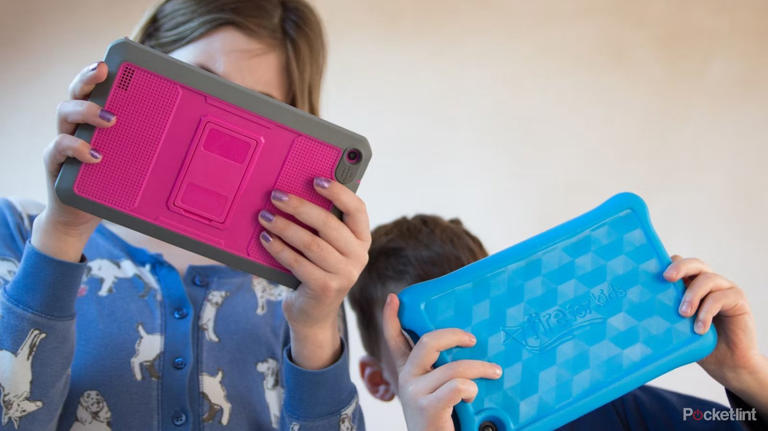
- Share full article
For more audio journalism and storytelling, download New York Times Audio , a new iOS app available for news subscribers.
Are ‘Forever Chemicals’ a Forever Problem?
The environmental protection agency says “forever chemicals” must be removed from tap water. but they lurk in much more of what we eat, drink and use..
This transcript was created using speech recognition software. While it has been reviewed by human transcribers, it may contain errors. Please review the episode audio before quoting from this transcript and email [email protected] with any questions.
From “The New York Times,” I’m Sabrina Tavernise. And this is “The Daily.”
[THEME MUSIC]
This month for the first time, the Environmental Protection Agency began to regulate a class of synthetic chemicals, known as forever chemicals, in America’s drinking water. But the chemicals, which have been linked to liver disease and other serious health problems, are in far more than just our water supply. Today, my colleague Kim Tingley explains.
It’s Wednesday, April 17.
So Kim, any time the EPA announces a regulation, I think we all sort of take notice because implicit in it is this idea that we have been exposed to something — something bad, potentially, lead or asbestos. And recently, the EPA is regulating a type of chemical known as PFAS So for those who don’t know, what are PFAS chemicals
Yeah, so PFAS stands for per and polyfluoroalkyl substances. They’re often called forever chemicals just because they persist so long in the environment and they don’t easily break down. And for that reason, we also use them in a ton of consumer products. They’re in makeup. They’re in carpet. They’re in nonstick cookware. They’re in food packaging, all sorts of things.
Yeah, I feel like I’ve been hearing about these chemicals actually for a very long time. I mean, nonstick pans, Teflon — that’s the thing that’s in my mind when I think PFAS.
Absolutely. Yeah, this class of chemicals has been around for decades. And what’s really important about this is that the EPA has decided, for the first time, to regulate them in drinking water. And that’s a ruling that stands to affect tens of millions of people.
So, help me understand where these things came from and how it’s taken so long to get to the point where we’re actually regulating them.
So, they really actually came about a long time ago. In 1938, DuPont, the people who eventually got us to Teflon, they were actually looking for a more stable kind of refrigerant. And they came upon this kind of chemical, PFAS. The thing that all PFAS chemicals have is a really strong bond between carbon atoms and fluorine atoms. This particular pairing is super strong and super durable.
They have water repellent properties. They’re stain resistant. They’re grease resistant. And they found a lot of uses for them initially in World War II. They were using them as part of their uranium enrichment process to do all these kinds of things. And then —
Well, good thing it’s Teflon.
In the 1950s is when they really started to come out as commercial products.
Even burned food won’t stick to Teflon. So it’s always easy to clean.
So, DuPont started using it in Teflon pans.
Cookware never needs scouring if it has DuPont Teflon.
And then another company, 3M also started using a kind of PFAS —
Scotchgard fabric protector. It keeps ordinary spills from becoming extraordinary stains.
— in one of their big products, Scotchgard. So you probably remember spraying that on your shoes if you want to make your shoes waterproof.
Use Scotchgard fabric protector and let your cup runneth over.
Right — miracle product, Scotchgard, Teflon. But of course, we’re talking about these chemicals because they’ve been found to pose health threats. When does that risk start to surface?
Yeah, so it’s pretty early on that DuPont and 3M start finding effects in animals in studies that they’re running in house.
Around the mid ‘60s, they start seeing that PFAS has an effect on rats. It’s increasing the liver and kidney weights of the rats. And so that seems problematic. And they keep running tests over the next decade and a half. And they try different things with different animals.
In one study, they gave monkeys really, really high levels of PFAS. And those monkeys died. And so they have a pretty strong sense that these chemicals could be dangerous. And then in 1979, they start to see that the workers that are in the plants manufacturing, working with these chemicals, that they’re starting to have higher rates of abnormal liver function. And in a Teflon plant, they had some pregnant workers that were working with these chemicals. And one of those workers in 1981 gave birth to a child who had some pretty severe birth defects.
And then by the mid 1980s, DuPont figures out that it’s not just their workers who are being exposed to these chemicals, but communities that are living in areas surrounding their Teflon plant, particularly the one in Parkersburg, West Virginia, that those communities have PFAS in their tap water.
Wow, so based on its own studies, DuPont knows its chemicals are making animals sick. They seem to be making workers sick. And now they found out that the chemicals have made their way into the water supply. What do they do with that information?
As far as we know, they didn’t do much. They certainly didn’t tell the residents of Parkersburg who were drinking that water that there was anything that they needed to be worried about.
How is that possible? I mean, setting aside the fact that DuPont is the one actually studying the health effects of its own chemicals, presumably to make sure they’re safe, we’ve seen these big, regulating agencies like the EPA and the FDA that exist in order to watch out for something exactly like this, a company that is producing something that may be harming Americans. Why weren’t they keeping a closer watch?
Yeah, so it goes kind of back to the way that we regulate chemicals in the US. It goes through an act called the Toxic Substances Control Act that’s administered by the EPA. And basically, it gives companies a lot of room to regulate themselves, in a sense. Under this act they have a responsibility to report to the EPA if they find these kinds of potential issues with a chemical. They have a responsibility to do their due diligence when they’re putting a chemical out into the environment.
But there’s really not a ton of oversight. The enforcement mechanism is that the EPA can find them. But this kind of thing can happen pretty easily where DuPont keeps going with something that they think might really be a problem and then the fine, by the time it plays out, is just a tiny fraction of what DuPont has earned from producing these chemicals. And so really, the incentive is for them to take the punishment at the end, rather than pull it out early.
So it seems like it’s just self-reporting, which is basically self-regulation in a way.
Yeah, I think that is the way a lot of advocacy groups and experts have characterized it to me, is that chemical companies are essentially regulating themselves.
So how did this danger eventually come to light? I mean, if this is in some kind of DuPont vault, what happened?
Well, there’s a couple different things that started to happen in the late ‘90s.
The community around Parkersburg, West Virginia, people had reported seeing really strange symptoms in their animals. Cows were losing their hair. They had lesions. They were behaving strangely. Some of their calves were dying. And a lot of people in the community felt like they were having health problems that just didn’t really have a good answer, mysterious sicknesses, and some cases of cancers.
And so they initiate a class action lawsuit against DuPont. As part of that class action lawsuit, DuPont, at a certain point, is forced to turn over all of their internal documentation. And so what was in the files was all of that research that we mentioned all of the studies about — animals, and workers, the birth defects. It was really the first time that the public saw what DuPont and 3M had already seen, which is the potential health harms of these chemicals.
So that seems pretty damning. I mean, what happened to the company?
So, DuPont and 3M are still able to say these were just a few workers. And they were working with high levels of the chemicals, more than a person would get drinking it in the water. And so there’s still an opportunity for this to be kind of correlation, but not causation. There’s not really a way to use that data to prove for sure that it was PFAS that caused these health problems.
In other words, the company is arguing, look, yes, these two things exist at the same time. But it doesn’t mean that one caused the other.
Exactly. And so one of the things that this class action lawsuit demands in the settlement that they eventually reach with DuPont is they want DuPont to fund a formal independent health study of the communities that are affected by this PFAS in their drinking water. And so they want DuPont to pay to figure out for sure, using the best available science, how many of these health problems are potentially related to their chemicals.
And so they ask them to pay for it. And they get together an independent group of researchers to undertake this study. And it ends up being the first — and it still might be the biggest — epidemiological study of PFAS in a community. They’ve got about 69,000 participants in this study.
Wow, that’s big.
It’s big, yeah. And what they ended up deciding was that they could confidently say that there was what they ended up calling a probable link. And so they were really confident that the chemical exposure that the study participants had experienced was linked to high cholesterol, ulcerative colitis, thyroid disease, testicular cancer, kidney cancer, and pregnancy induced hypertension.
And so those were the conditions that they were able to say, with a good degree of certainty, were related to their chemical exposure. There were others that they just didn’t have the evidence to reach a strong conclusion.
So overall, pretty substantial health effects, and kind of vindicates the communities in West Virginia that were claiming that these chemicals were really affecting their health.
Absolutely. And as the years have gone on, that was sort of just the beginning of researchers starting to understand all the different kinds of health problems that these chemicals could potentially be causing. And so since the big DuPont class action study, there’s really just been like this building and building and building of different researchers coming out with these different pieces of evidence that have accumulated to a pretty alarming picture of what some of the potential health outcomes could be.
OK, so that really kind of brings us to the present moment, when, at last, it seems the EPA is saying enough is enough. We need to regulate these things.
Yeah, it seems like the EPA has been watching this preponderance of evidence accumulate. And they’re sort of deciding that it’s a real health problem, potentially, that they need to regulate.
So the EPA has identified six of these PFAS chemicals that it’s going to regulate. But the concern that I think a lot of experts have is that this particular regulation is not going to keep PFAS out of our bodies.
We’ll be right back.
So, Kim, you just said that these regulations probably won’t keep PFAS chemicals out of our bodies. What did you mean?
Well, the EPA is talking about regulating these six kinds of PFAS. But there are actually more than 10,000 different kinds of PFAS that are already being produced and out there in the environment.
And why those six, exactly? I mean, is it because those are the ones responsible for most of the harm?
Those are the ones that the EPA has seen enough evidence about that they are confident that they are probably causing harm. But it doesn’t mean that the other ones are not also doing something similar. It’s just sort of impossible for researchers to be able to test each individual chemical compound and try to link it to a health outcome.
I talked to a lot of researchers who were involved in this area and they said that they haven’t really seen a PFAS that doesn’t have a harm, but they just don’t have information on the vast majority of these compounds.
So in other words, we just haven’t studied the rest of them enough yet to even know how harmful they actually are, which is kind of alarming.
Yeah, that’s right. And there’s just new ones coming out all the time.
Right. OK, so of the six that the EPA is actually intending to regulate, though, are those new regulations strict enough to keep these chemicals out of our bodies?
So the regulations for those six chemicals really only cover getting them out of the drinking water. And drinking water only really accounts for about 20 percent of a person’s overall PFAS exposure.
So only a fifth of the total exposure.
Yeah. There are lots of other ways that you can come into contact with PFAS. We eat PFAS, we inhale PFAS. We rub it on our skin. It’s in so many different products. And sometimes those products are not ones that you would necessarily think of. They’re in carpets. They’re in furniture. They’re in dental floss, raincoats, vinyl flooring, artificial turf. All kinds of products that you want to be either waterproof or stain resistant or both have these chemicals in them.
So, the cities and towns are going to have to figure out how to test for and monitor for these six kinds of PFAS. And then they’re also going to have to figure out how to filter them out of the water supply. I think a lot of people are concerned that this is going to be just a really expensive endeavor, and it’s also not really going to take care of the entire problem.
Right. And if you step back and really look at the bigger problem, the companies are still making these things, right? I mean, we’re running around trying to regulate this stuff at the end stage. But these things are still being dumped into the environment.
Yeah. I think it’s a huge criticism of our regulatory policy. There’s a lot of onus put on the EPA to prove that a harm has happened once the chemicals are already out there and then to regulate the chemicals. And I think that there’s a criticism that we should do things the other way around, so tougher regulations on the front end before it goes out into the environment.
And that’s what the European Union has been doing. The European Chemicals Agency puts more of the burden on companies to prove that their products and their chemicals are safe. And the European Chemicals Agency is also, right now, considering just a ban on all PFAS products.
So is that a kind of model, perhaps, of what a tough regulation could look like in the US?
There’s two sides to that question. And the first side is that a lot of people feel like it would be better if these chemical companies had to meet a higher standard of proof in terms of demonstrating that their products or their chemicals are going to be safe once they’ve been put out in the environment.
The other side is that doing that kind of upfront research can be really expensive and could potentially limit companies who are trying to innovate in that space. In terms of PFAS, specifically, this is a really important chemical for us. And a lot of the things that we use it in, there’s not necessarily a great placement at the ready that we can just swap in. And so it’s used in all sorts of really important medical devices or renewable energy industries or firefighting foam.
And in some cases, there are alternatives that might be safer that companies can use. But in other cases, they just don’t have that yet. And so PFAS is still really important to our daily lives.
Right. And that kind of leaves us in a pickle because we know these things might be harming us. Yet, we’re kind of stuck with them, at least for now. So, let me just ask you this question, Kim, which I’ve been wanting to ask you since the beginning of this episode, which is, if you’re a person who is concerned about your exposure to PFAS, what do you do?
Yeah. So this is really tricky and I asked everybody this question who I talked to. And everybody has a little bit of a different answer based on their circumstance. For me what I ended up doing was getting rid of the things that I could sort of spot and get rid of. And so I got rid of some carpeting and I checked, when I was buying my son a raincoat, that it was made by a company that didn’t use PFAS.
It’s also expensive. And so if you can afford to get a raincoat from a place that doesn’t manufacture PFAS, it’s going to cost more than if you buy the budget raincoat. And so it’s kind of unfair to put the onus on consumers in that way. And it’s also just not necessarily clear where exactly your exposure is coming from.
So I talk to people who said, well, it’s in dust, so I vacuum a lot. Or it’s in my cleaning products, so I use natural cleaning products. And so I think it’s really sort of a scattershot approach that consumers can take. But I don’t think that there is a magic approach that gets you a PFAS-free life.
So Kim, this is pretty dark, I have to say. And I think what’s frustrating is that it feels like we have these government agencies that are supposed to be protecting our health. But when you drill down here, the guidance is really more like you’re on your own. I mean, it’s hard not to just throw up your hands and say, I give up.
Yeah. I think it’s really tricky to try to know what you do with all of this information as an individual. As much as you can, you can try to limit your individual exposure. But it seems to me as though it’s at a regulatory level that meaningful change would happen, and not so much throwing out your pots and pans and getting new ones.
One thing about PFAS is just that we’re in this stage still of trying to understand exactly what it’s doing inside of us. And so there’s a certain amount of research that has to happen in order to both convince people that there’s a real problem that needs to be solved, and clean up what we’ve put out there. And so I think that we’re sort of in the middle of that arc. And I think that that’s the point at which people start looking for solutions.
Kim, thank you.
Here’s what else you should know today. On Tuesday, in day two of jury selection for the historic hush money case against Donald Trump, lawyers succeeded in selecting 7 jurors out of the 12 that are required for the criminal trial after failing to pick a single juror on Monday.
Lawyers for Trump repeatedly sought to remove potential jurors whom they argued were biased against the president. Among the reasons they cited were social media posts expressing negative views of the former President and, in one case, a video posted by a potential juror of New Yorkers celebrating Trump’s loss in the 2020 election. Once a full jury is seated, which could come as early as Friday, the criminal trial is expected to last about six weeks.
Today’s episode was produced by Clare Toeniskoetter, Shannon Lin, Summer Thomad, Stella Tan, and Jessica Cheung, with help from Sydney Harper. It was edited by Devon Taylor, fact checked by Susan Lee, contains original music by Dan Powell, Elisheba Ittoop, and Marion Lozano, and was engineered by Chris Wood.
Our theme music is by Jim Brunberg and Ben Landsverk of Wonderly.
That’s it for The Daily. I’m Sabrina Tavernise. See you tomorrow.

- April 18, 2024 • 30:07 The Opening Days of Trump’s First Criminal Trial
- April 17, 2024 • 24:52 Are ‘Forever Chemicals’ a Forever Problem?
- April 16, 2024 • 29:29 A.I.’s Original Sin
- April 15, 2024 • 24:07 Iran’s Unprecedented Attack on Israel
- April 14, 2024 • 46:17 The Sunday Read: ‘What I Saw Working at The National Enquirer During Donald Trump’s Rise’
- April 12, 2024 • 34:23 How One Family Lost $900,000 in a Timeshare Scam
- April 11, 2024 • 28:39 The Staggering Success of Trump’s Trial Delay Tactics
- April 10, 2024 • 22:49 Trump’s Abortion Dilemma
- April 9, 2024 • 30:48 How Tesla Planted the Seeds for Its Own Potential Downfall
- April 8, 2024 • 30:28 The Eclipse Chaser
- April 7, 2024 The Sunday Read: ‘What Deathbed Visions Teach Us About Living’
- April 5, 2024 • 29:11 An Engineering Experiment to Cool the Earth
Hosted by Sabrina Tavernise
Featuring Kim Tingley
Produced by Clare Toeniskoetter , Shannon M. Lin , Summer Thomad , Stella Tan and Jessica Cheung
With Sydney Harper
Edited by Devon Taylor
Original music by Dan Powell , Elisheba Ittoop and Marion Lozano
Engineered by Chris Wood
Listen and follow The Daily Apple Podcasts | Spotify | Amazon Music
The Environmental Protection Agency has begun for the first time to regulate a class of synthetic chemicals known as “forever chemicals” in America’s drinking water.
Kim Tingley, a contributing writer for The New York Times Magazine, explains how these chemicals, which have been linked to liver disease and other serious health problems, came to be in the water supply — and in many more places.
On today’s episode
Kim Tingley , a contributing writer for The New York Times Magazine.

Background reading
“Forever chemicals” are everywhere. What are they doing to us?
The E.P.A. issued its rule about “forever chemicals” last week.
There are a lot of ways to listen to The Daily. Here’s how.
We aim to make transcripts available the next workday after an episode’s publication. You can find them at the top of the page.
Fact-checking by Susan Lee .
The Daily is made by Rachel Quester, Lynsea Garrison, Clare Toeniskoetter, Paige Cowett, Michael Simon Johnson, Brad Fisher, Chris Wood, Jessica Cheung, Stella Tan, Alexandra Leigh Young, Lisa Chow, Eric Krupke, Marc Georges, Luke Vander Ploeg, M.J. Davis Lin, Dan Powell, Sydney Harper, Mike Benoist, Liz O. Baylen, Asthaa Chaturvedi, Rachelle Bonja, Diana Nguyen, Marion Lozano, Corey Schreppel, Rob Szypko, Elisheba Ittoop, Mooj Zadie, Patricia Willens, Rowan Niemisto, Jody Becker, Rikki Novetsky, John Ketchum, Nina Feldman, Will Reid, Carlos Prieto, Ben Calhoun, Susan Lee, Lexie Diao, Mary Wilson, Alex Stern, Dan Farrell, Sophia Lanman, Shannon Lin, Diane Wong, Devon Taylor, Alyssa Moxley, Summer Thomad, Olivia Natt, Daniel Ramirez and Brendan Klinkenberg.
Our theme music is by Jim Brunberg and Ben Landsverk of Wonderly. Special thanks to Sam Dolnick, Paula Szuchman, Lisa Tobin, Larissa Anderson, Julia Simon, Sofia Milan, Mahima Chablani, Elizabeth Davis-Moorer, Jeffrey Miranda, Renan Borelli, Maddy Masiello, Isabella Anderson and Nina Lassam.
Advertisement

IMAGES
VIDEO
COMMENTS
Plan to spend no more than 15 minutes in the station on any one visit. It's a place of business, so they must stick to a schedule. Prepare a list of 3 or 4 questions for YOUR CHILD to ask the firefighters so he/she can learn something new on each visit.
No Hiding. One of the most helpful suggestions for young kids is to NEVER hide if there is a fire. They stressed that kids should not go under the bed, in the closet, behind furniture, etc. When fire fighters enter a home, they often can't see well because of the smoke. They need family members easily visible so they can get them out quickly.
There are lots of benefits to visiting the fire station, but the biggest (in my mind) was letting the children see a firefighter in his full gear (including the helmet and respirator). I can imagine it being quite scary seeing a fireman in all his gear when there is actually a fire. Firefighters have said that some children have actually run ...
Not all cities do it, but it's certainly worth a call to your local fire department or city hall to see if they do it and how to register. 2. Teach them to stop, drop, roll. This is a must. When people accidentally light themselves on fire the natural response is to panic and run. This is the worst thing you can do if your clothing is on fire.
Step 3: During the Visit. During the tour, encourage your baby to interact with the firefighters and ask questions. Firefighters can show your child the fire trucks, explain their gear, and talk about fire safety. However, ensure your baby respects the equipment and follows any instructions or safety rules given by the firefighters.
Fire Station Visit. Directions. Go to the library and find a book about firemen and firefighting. Read the book to your child a few times and write down the list of questions your child asks about how houses start on fire, who gets to be a fireman, and how they get to the fire so fast. Explain the responsibilities of the local firefighters and ...
Making a Fire Station Visit Even More Fun. To make your visit even more engaging, you can really make it memorable by including some toys for your kids to play with that truly help emulate real life, relatable heroes. Rescue Heroes from Fisher-Price aim to stimulate a child's imagination and sense of adventure without using violence.
One of the most memorable field trips a child can go on is a visit to the local fire station. There's just something about seeing all the firefighting equipment up close, getting to touch the fire truck (and even maybe get to sit or stand on it) and getting to talk to a real firefighter that stays with a kid ...
Fire Station Field Trip. Activities. For today's virtual adventure, we're visiting a Fire Station! A trip to the station is the perfect way to teach your little ones about our first responders, and about fire safety. Head to your closet and put on your favorite jeans and graphic tee's and get ready to explore!
After Your Visit. After visiting your local fire station, have your child keep an eye out for different types of fire trucks around your town. See if he or she can identify them and recall what role they play in fighting fires. In addition to spotting trucks driving around town, look for trucks being cleaned outside firehouses.
However, you can also call or visit your local fire station to arrange a tour with your kids. At the fire station, they can meet firefighting men and women, ask them questions and possibly even sit in a firetruck. Whether kids meet firefighters in the classroom or on a fire station tour, this hands-on experience teaches kids that firefighters:
4. Prepare Your Child. Talk to your child beforehand about some of the things you might see. The fire trucks, the fire fighters. Older kids could also brainstorm questions that they want to ask the firefighters on your trip. 5. Talk about Expectation. I think this is a good idea anytime you go anywhere.
5. Have breakfast together. We already know that firefighters love food, so a super fun way to spend time at the station is with breakfast! The cool thing about breakfast is that it can be done before, during or after shift. WIth such a versatile time frame this is a fun activity that can be low key and low stress.
The children can be heard singing their songs about fire stations and fire trucks as the preschool van pulls into the fire station parking lot. It is at this point where the excitement peaks. The firefighters are fully prepared to greet the children and their impressive fire trucks can be seen glistening in the bright Florida sunlight.
Step 1. Most fire departments have materials and outreach staff to teach young children about fire safety. Contact your local fire department ahead of time and inquire about whether a visit to the station is possible. If it would be difficult to take a field trip with your group, ask if they have staff available to visit your setting.
In our latest virtual field trip, Miss Penny and the KidVision Kids visit the fire station to learn about fire safety. They discover the different parts of a fire truck, tour the station house, and learn about the importance of fire drills and exit signs. The children even get to demonstrate how to Stop, Drop, and Roll!
Typically, you can do this either with a phone call or an online request. You'll want to call again before you head to the station on the day of your visit. You never know when the firefighters will need to respond to a call. That's why you also need to have a back-up plan. Find a park, library or indoor play area near the fire station.
Review your fire safety plan with a member of your local fire department. Bring your child with you to the fire station so they can see the fire trucks and learn not to fear the firefighters. Ask the firefighters if your community has a special needs disaster registry, so you can provide as much advance information as possible about your family ...
One container of ice cream or one pie should suffice. However, if there are 10 or more firefighters on duty, don't walk in with one container of ice cream. Do your homework in advance; if worse ...
Join Caitie on a field trip to a fire station in Toronto to learn all about the job of a firefighter and how they keep us safe. CONNECT WITH CAITIE Caitie's...
The department responds to an average of 2,200 emergency calls and performs numerous fire prevention inspections each year. The department staffs three fire stations on a full time basis. Fire Headquarters is located at 77 Hudson Road, Station #2 is at 550 Boston Post Road (Rte. 20) and Station #3 is located at 268 North Road (Rte. 117).
A visit to the station may seem inconsequential at the time, but I promise you, it's not. It is a memory your children will talk about for the rest of their lives, and it is a chance for you and your spouse to reconnect and remember why they are there in the first place. We are thankful and grateful to the LAFD for the opportunity of allowing ...
So we went down there with like 10-12 parents and 8-10 kids and the kids LOVED it. They got to climb in and on all the trucks and try on some of the equipment (like jackets and boots and helmets). There were also 3-4 firefighters there who talked about what they do and demonstrated equipment and answered questions.
WHITMAN, Mass. (Gray News) - A 10-year-old boy was rescued after getting stuck in a chimney. On April 10, Whitman Fire Department said it responded to a 911 call about a 10-year-old child who had ...
Creating a child profile allows you to personalize your child's experience with age-appropriate content and settings on a Fire tablet. Access Settings: Swipe down and tap the gear icon. Go to ...
Featuring Kim Tingley. Produced by Clare Toeniskoetter , Shannon M. Lin , Summer Thomad , Stella Tan and Jessica Cheung. With Sydney Harper. Edited by Devon Taylor. Original music by Dan Powell ...